Plane stupid?
So I stopped collecting the James Bond Car Collection near the end as there were too many filler cars, just seen for a few seconds.
And then I began to collect James Bond planes, just seen for a few seconds ... ;%
It all began about a year ago when I viewed a Corgi Drax helicopter on ebay and one of the “similar items” shown at the bottom was a 1:400 scale Lockheed Electra in Drax Air Freight livery. As it was one of a limited edition of only 120 pieces for a certain “Hangar Club” I decided to bid and won it for about $40.
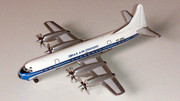
After receiving the packet I was very disappointed as it was much smaller than I had expected. From the details of propellers and landing gear and the neat tampoprints I had thought that the plane would be quite a bit larger. I guess the “1:400” part of the description should have told me something ...
Actually, 1:400 is a popular scale for collectors of airliners, and when you have a modern jet in hand it is a well-chosen scale as such planes in 1:200 are consuming too much space to collect a fleet. It is just that the older airliners like the Electra were so much smaller than today’s and for such small aircraft the larger scales 1:200 or 1:144 are probably better suited unless, of course, one prefers a fleet in a consistent scale. Committing to 1:400 scale also means a restriction to airliners or large military aircraft as small fighters or helicopters aren’t made in this scale.
Although disappointed at first I have come to like this tiny model and after having my first 1:400 plane in the collection I looked if any other, more memorable Bond-connected aircraft had been produced in the same scale. I didn’t expect the “Skyfleet S570” from CR as this would need an extensively modified 747 mould not reuseable for anything else – but something like the 747 shuttle carrier in Moonraker livery or the DC-3 from QoS, using already existing moulds with just a different decoration. I don’t think it would be too difficult to sell 120 pieces of those worldwide, the usual quantity for the Hangar Club models. Although other fantasy aircraft – like the Boeing 707 from Airport and the 747 from Airport ’75 – have been released as Hangar Club models, unfortunately no other Bond models exist in 1:400. (Other scales aren’t any better, with the Drax Electra not even available in any other scale.)
Having looked up the different aircraft that have featured in the Bond films, ranging from the once-ubiquitous 707 to the exotic ATL Carvair, I tried to find models in the same period livery, and in a few cases even a model with the same registration can be found. I also decided later to add the planes from the Fleming novels which include illustrious names like the Stratocruiser, Caravelle and the iconic Super Constellation.
I searched for info about the prototypes on sites like airliners.net, the International Movie Plane Database impdb.org or the James Bond Locations blog jamesbondlocations.blogspot.co.uk and also enjoyed trying to find the mentioned flights in old timetables; in passing answering such age-old questions like “Did Pan Am flight no. 1 really go from London to Istanbul?” or “Why take Lufthansa from Amsterdam to L.A. instead of KLM?”. The essential resource for this was timetableimages.com. So instead of just showing some photos of tiny toy planes I will also add some info about the prototypes and the appropriate timetables.
As I am still looking for some models from films and novels, including a Pan Am 707 from the first two films, I’ll start with the one “real” James Bond collectible and then continue in no particular order, and if anyone is interested there will be more instalments in the future.
Lockheed L-188 Electra, Drax Air Freight (Varig), PP-DRX
Moonraker
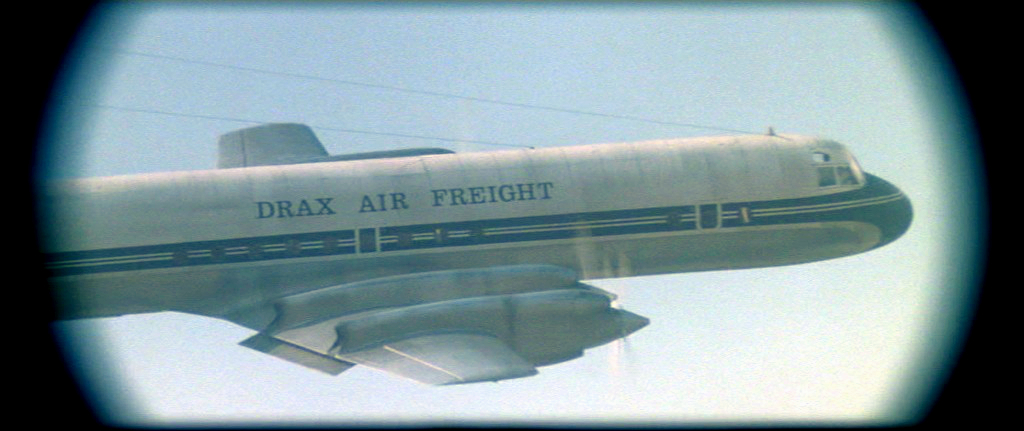
Excerpts quoted (with kind permission) from jamesbondlocations.blogspot.co.uk/search/label/Varig%20Brazil. -{ I am only quoting the passages concerning the aircraft and airlines but not the locations parts about the airports, so I can only recommend visiting the site:
“In Moonraker Bond goes to Rio to investigate the affairs of Hugo Drax. In a warehouse belonging to the importer firm ‘C&W’ (Carlos & Wilmsberg) in downtown Rio, Bond learns that Drax is moving his merchandise through his cargo airline ‘Drax Air Freight’. Manuela tells Bond that ‘Drax Air Freight’ operates out of San Pedro Airport and Bond gets up to the Sugarloaf mountain to check it out.
The airport can be seen from the viewpoint on top of the mountain, no doubt one of the most famous tourist attractions in Rio. In reality the airport is called Santos Dumont Airport, after a Brazilian aviation pioneer. Why San Pedro was used instead of the real name is unclear.
The Drax Air Freight plane however is a Lockheed L-188 Electra, in reality belonging to Varig Airways, the leading Brazilian airline at the time. The dark blue plane livery can be recognized if you compare Drax’s plane with the Varig plane in the picture below. Santos Dumont airport was one of the main airports that Varig used in Brazil. In 1959 together with two other airlines, Varig had initiated an “air shuttle service” between Rio-Santos Dumont airport and São Paolo airport. The three airlines coordinated their schedules and operations and shared their revenue. Due to the success of this shuttle service led by Varig, it was abandoned only in 1999. The interesting fact is that this route was served exclusively by Varig’s Lockheed L-188 Electra between 1975 and 1992 and the aircraft used on this route did not have the Varig name on the fuselage for the sake of neutrality to the other two airlines. This would have made it easy for the filmmakers to use one of Varig’s aircraft in the film and put the name “Drax Air Freight” on the side, since the fuselage didn’t have the Varig logo on it.
The Lockheed L-188 was developed in the 1950’s by the American manufacturer Lockheed. It first flew in 1957 and was the first large American turboprop airliner. However, the engines would soon be replaced by turbojets and many of the aircraft that still used this engine type were modified as freighters.
Varig was the leading and almost only international airline in Brazil between the years 1965 and 1990. Beginning with the new millennium, Varig experienced financial difficulties and after a reconstruction and two failed attempts to auction the airline, Varig was split into two companies. The call sign ceased to exist in 2008.”
Maybe worth adding is that while the Electra was not the success Lockheed had hoped for, the U.S. Navy variant P-3 Orion was, with 650 built and one of only a few aircraft types with more than 50 years of service with U.S. armed forces.
The model: Lockheed L-188 Electra, Drax Air Freight, PP-DRX
AeroClassics, Hangar Club HC-002, 1:400
This was released in 2003 or 2004 as the second exclusive model for members of the Hangar Club of which I don’t know much about. I have seen a few of their exclusive models but no other James Bond models were made. The Electra comes in a white box without model identification but with an individually numbered collector card.
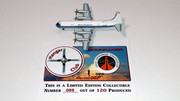
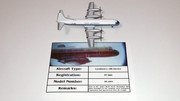

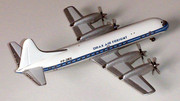

The AeroClassics Electra is nicely done but the Drax Air Freight typeface is different to the one used on the real plane. AeroClassics seems to have used the sans-serif font used by Varig but the Drax Air Freight was painted on with a serif font similar to Excelsior. It could be that the colour was black rather than Varig blue. The nose is clearly shorter than in the photo but it is possible that the real plane AeroClassics used as a prototype for their Electra mould had a different shape than Varig’s plane as later installed radar equipment often necessitated the alteration of the nose. The model manufacturers often make just one mould for many variations, and the decision left to collectors is to accept some differences or not get a desired model at all. Window and door configurations often match very well as those are only printed onto the fuselage, there are no inset windows.
Just to give a sense of scale – here with the Corgi helicopters which will be familiar to many and are about 1:64 and 1:128 for the Junior.
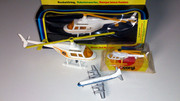
And here with a 747 for a size comparison. I will use this with every model as most of you can imagine the size of a 747 but few will have seen a Lockheed Electra, Vickers Viscount or Boeing 377 in real life before. All models I show are to the same scale, 1:400.
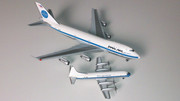
As I am still looking for a 707 from DN and FRWL, I continue with an interesting prototype from the novels – the Boeing Stratocruiser which was guest-starring in several of Fleming’s books:
Boeing 377 Stratocruiser, BOAC
Live and Let Die novel
Diamonds Are Forever novel
Goldfinger novel
For Your Eyes Only short story
007 in New York short story
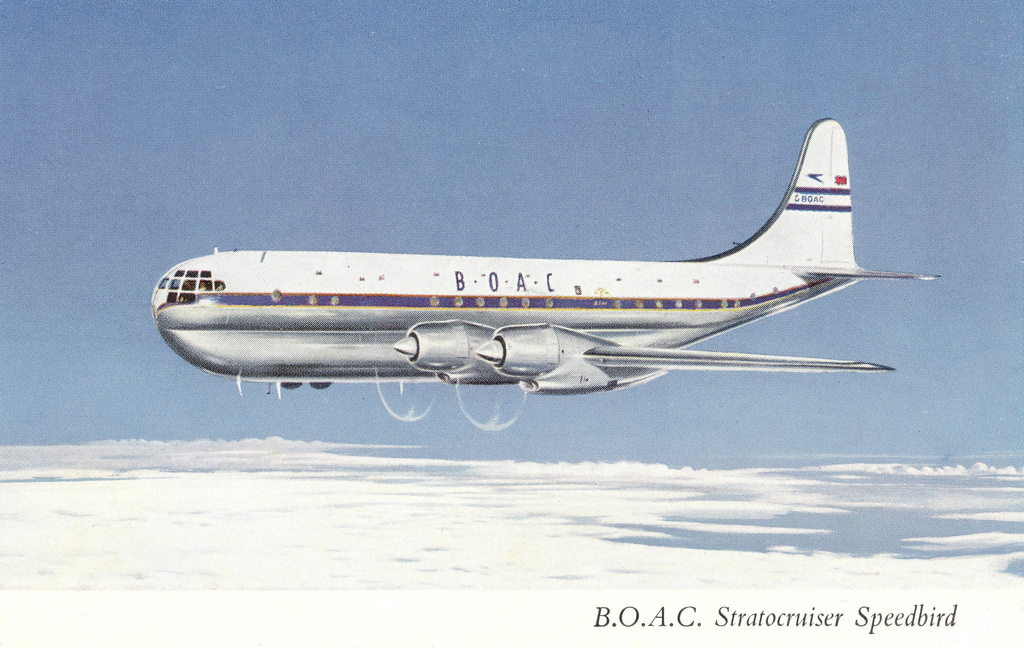
“From the moment the B.O.A.C. Stratocruiser taxied up to the International Air Terminal at Idlewild, James Bond was treated like royalty”
– Ian Fleming, Live and Let Die (1954)
“... and then they were all walking across the tarmac and up into the big Boeing and, with a burst of oil and methanol smoke, the engines fired one by one. The chief steward announced over the loudspeaker that the next stop would be Shannon, where they would dine, and that the flying time would be one hour and fifty minutes, and the great double-decker Stratocruiser rolled slowly out to the east–west runway. The aircraft trembled against its brakes as the Captain revved the four engines, one at a time, up to take-off speed, and through his window Bond watched the wing flaps being tested. Then the great plane turned slowly towards the setting sun, there was a jerk as the brakes were released and the grass on either side of the runway flattened as, gathering speed, the Monarch hurtled down the two miles of stressed concrete and rose into the west, aiming ultimately for another little strip of concrete carpet on the other side of the world”
– Ian Fleming, Diamonds Are Forever (1956)
“Will Mr James Bond, passenger on B.O.A.C. Monarch Flight No. 510 to Gander and London, please come to the B.O.A.C. ticket counter”
“The theft of a Stratocruiser, as Goldfinger had explained it, was preposterous, but no more so than his methods of smuggling gold”
“This is Ocean Station Charlie calling Speedbird 510. Charlie calling G-ALGY. Can you hear me? Come in Speedbird 510”
“... when the belly of the Stratocruiser had thudded into the first mountain of swell at a hundred miles an hour. The huge plane skipped once and then crashed nose first into a wall of water. The impact had broken the back of the plane”
– Ian Fleming, Goldfinger (1959)
“Two days later, Bond took the Friday Comet to Montreal. He did not care for it. It flew too high and too fast and there were too many passengers.
He regretted the days of the old Stratocruiser – that fine lumbering old plane that took ten hours to cross the Atlantic. Then one had been able to have dinner in peace, sleep for seven hours in a comfortable bunk, and get up in time to wander down to the lower deck and have that ridiculous B.O.A.C. ‘country house’ breakfast while the dawn came up and flooded the cabin with the first bright gold of the Western hemisphere. Now it was all too quick”
– Ian Fleming, For Your Eyes Only (1960)
“It was just 10 a.m. on a blue and golden late September morning and the B.O.A.C. Monarch Flight 505 from London had landed at Idlewild”
– Ian Fleming, 007 in New York (1963)
Although I’ve been interested in aviation history since I was a child I had never heard of the Boeing Stratocruiser before I looked for the Bond aircraft. The B377 was one of the last airliner developments with piston engines to enter service, in 1949, and as such was seen as the end of an era. Every major manufacturer was already working on turbine-powered successors in either jet or turboprop form, with the first jetliner (the ill-fated Comet 1) following just three years after the B377.
The Stratocruiser was the civilian version of the U.S. Air Force C-97 freighter, itself an enlarged B-29/B-50 bomber from which the Stratocruiser inherited the rounded nose, Wasp Major engines, wings and tailfin. The latter was so high that it could be folded sideways to fit into the existing hangars.
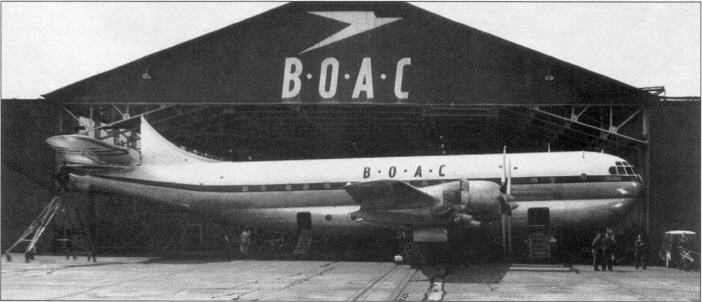
The Stratocruiser was a double-deck design and offered a “comfortable lower-deck lounge, with its well-stocked bar and gay, convivial atmosphere” and unprecedented luxury on the main level, including sleeping berths and, with some other airlines, even a private sleeping room in the tail section. In first-class configuration as used on the BOAC Monarch flights it accommodated less than 40 passengers.
Powered by four 28-cylinder radial engines each developing 3,500 hp, those massive engines and the propellers were the source of many problems, and it was obvious that a piston engine would not reliably provide yet more power for the larger aircraft then on the drawing boards. The Stratocruiser was plagued with in-flight engine fires, loose propeller blades or even whole engines falling off the wings after the engine mounts broke.
There were ten fatal crashs involving Stratocruisers during the 1950s; BOAC lost one on Christmas Day 1954 at Glasgow-Prestwick, killing 28 of the 36 on board.
BOAC used the type from 1950 till 1959. All in all, the Stratocruiser was expensive to buy and operate, and was a commercial failure for the airlines, and for Boeing which built only 56. However, its advanced fuselage construction principles were later successfully applied to the 707. Some Stratocruisers were later converted to Guppy freighters for oversize loads, like parts of the NASA Saturn rockets.
Ian Fleming mentions two flight numbers: “B.O.A.C. Monarch Flight 505 from London had landed at Idlewild” in the 007 in New York short story, and “B.O.A.C. Monarch Flight No. 510 to Gander and London” in Goldfinger.
According to John Griswold’s fictional James Bond chronology (en.wikipedia.org/wiki/List_of_James_Bond_novels_and_short_stories#Fictional_chronologies) Goldfinger is set from April to June 1957, and 007 in New York in late September 1961. The luxury Monarch service was introduced in 1951 on the London–New York route only for a single Stratocruiser flight pair but in later years the name was also used on other aircraft like the Douglas DC-7, Bristol Britannia, De Havilland Comet 4 and Boeing 707.
So, off to www.timetableimages.com, to the list of complete timetables, and we find a BOAC one from April 14, 1957; should be perfect for Goldfinger:
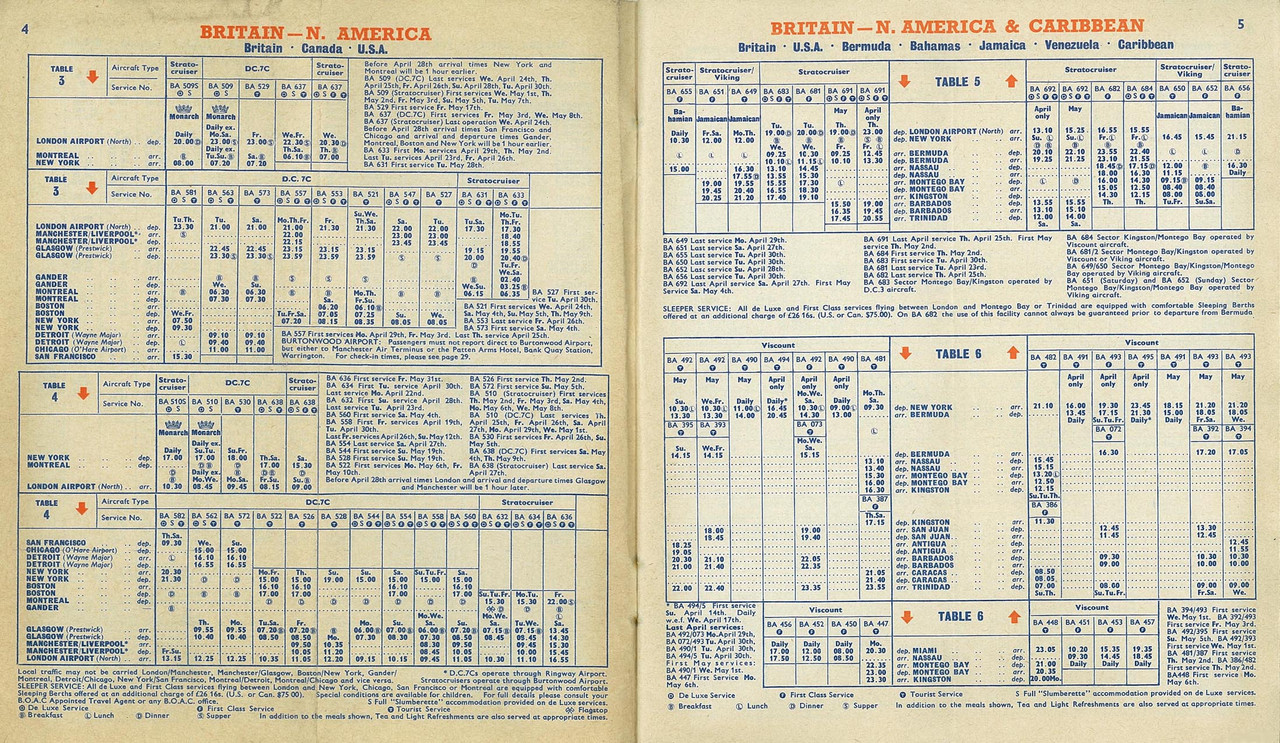
(BOAC timetable April 14, 1957 – www.timetableimages.com/ttimages/ba2/ba57/)
In Table 4 we find flights BA 510S (Stratocruiser) and BA 510 (DC-7C) and read that DC-7s are used until May 1st, with Stratocruisers resuming service from May 2nd. I guess that the newer DC-7s were employed during the winter season in the later years of Stratocruiser service. (If the timetable is too small to read then open in a new tab, as the large scans are automatically reduced to frame width on this site.)
BA 510S, Stratocruiser, Monarch flight, departing New York daily 17.00 (that’s 5 p.m. ), arriving London next day 10.30.
), arriving London next day 10.30.
The Gander stop is not shown in the table as this was only a technical stop for refueling. Fleming’s text checks out fine, except no BOAC Stratocruiser carried the registration G-ALGY.
The search for BOAC Monarch flight 505 was a bit more difficult. In the August 1961 timetable we find several Monarch flights (all with 707 jets by then), including the venerable ex-Stratocruiser numbers 501 and 509. But no 505.
After going back a few years I found flight 505 in the 1950 and 1951 timetables:
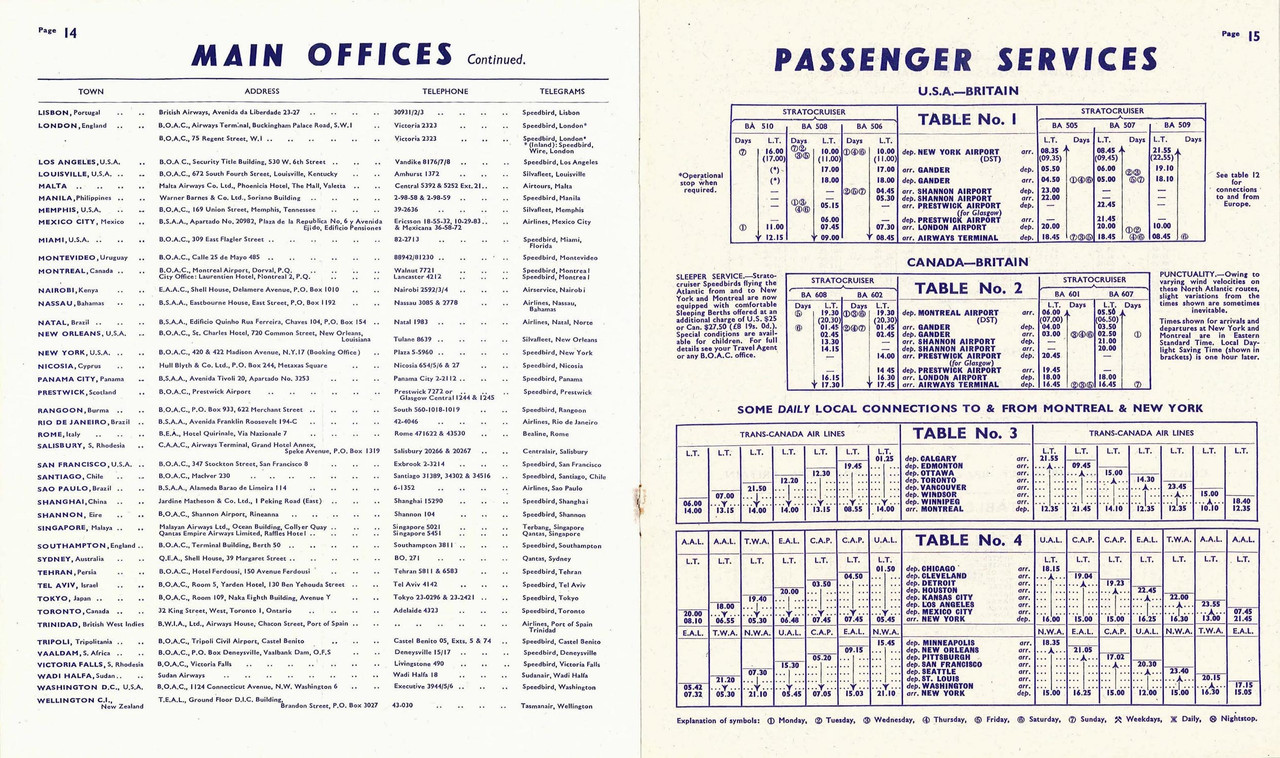
(BOAC timetable July 1, 1950 – www.timetableimages.com/ttimages/ba2/ba5007/)
1950 was before the introduction of the Monarch service, so the later Monarch flights 509/510 are shown as “ordinary” first-class flights though the mentioned sleeper berths were already available for an “additional charge of U.S. $25 or Can. $27.50 (£8 19s. 0d.)”.
(By 1957 the charge for a berth had risen to U.S./Can. $75/£26 16s.)
BA 505, departing London on Sunday/Wednesday/Friday 20.00, Shannon arr 22.00/dep 23.00, Gander arr 4.50/dep 5.50, New York arr 8.35 (or 9.35 daylight saving time as it was a “late September morning”).
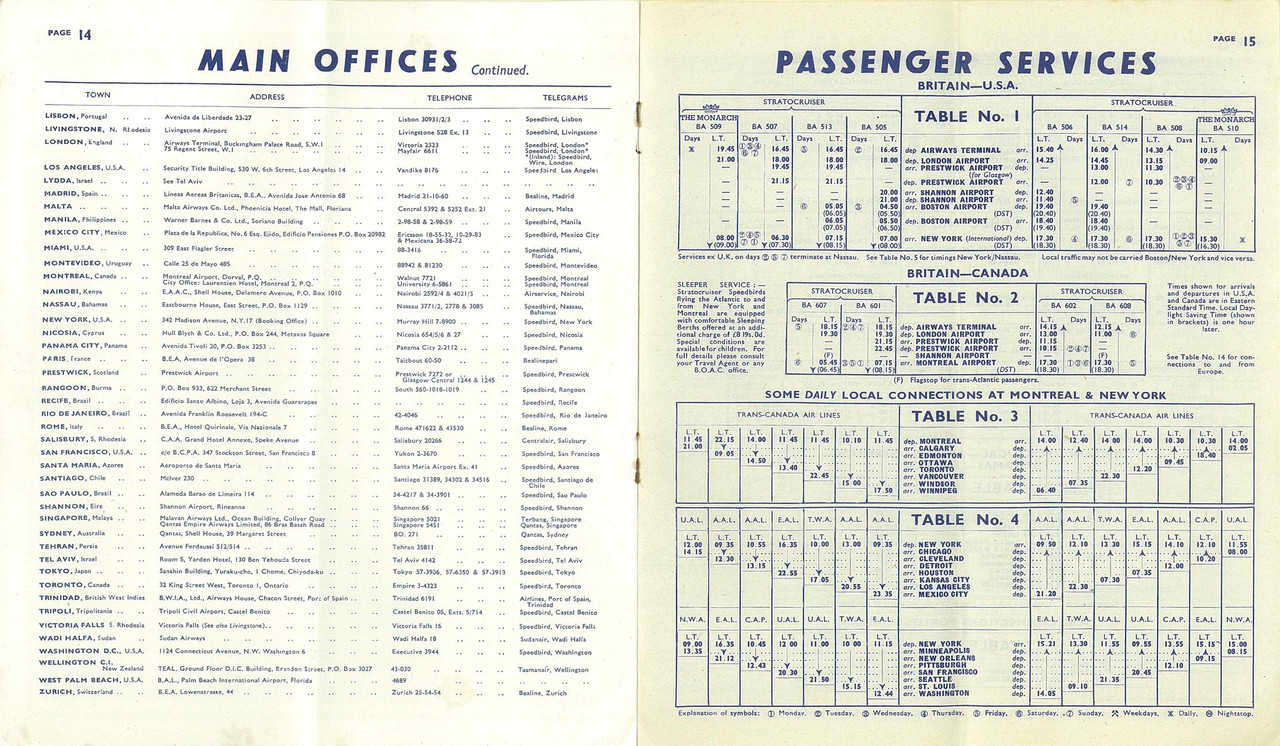
(BOAC timetable July 1, 1951 – www.timetableimages.com/ttimages/ba2/ba51/)
1951 shows the new Monarch flights (509/510). BA 505 was no Monarch flight (but still: this was all-first class, so maybe the cause for confusion), departing London (Tuesdays only) at 18.00, Shannon arr 20.00/dep 21.00, Boston arr 5.50 DST/dep 6.50 DST, New York arr 8.00 DST.
This timetable also shows fares: London–New York cost £133 19s., return £241 3s.
A 1952 timetable is not available but in 1953 flight no. 505 is no longer listed. As 007 in New York was published in 1963 and is allegedly set in September 1961, this seems like an awfully old timetable Fleming used when writing the story. As he was a frequent flyer between London and Jamaica I can’t imagine him having a ten year old BOAC timetable lying around. Could it be that this short story was written much earlier?
I don’t think that 505 is just a typo and Fleming meant the real Monarch flight BA 509 – he also mentions “the Monarch” in DAF but describes the stop at Shannon airport not made by the Monarchs (those were direct flights with only a fuel stop in Gander, Newfoundland).
BA 505 looks like the perfect match for the DAF flight but this conflicts with the fictional chronologies: John Griswold places DAF in July 1953; and Henry Chancellor in 1954 – the Stratocruiser flights to New York with intermediate stops (BA 507/513/515) were routed via Glasgow-Prestwick, not Shannon, in those years.
The model: Boeing 377 Stratocruiser, BOAC, G-AKGH “Caledonia”
AeroClassics ACGAKGH, 1:400
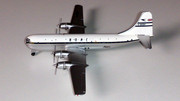
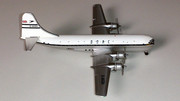
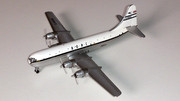

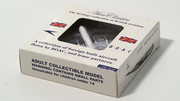
G-AKGH was delivered to BOAC in November 1949, in a bare-metal finish. It was soon repainted in this livery with white top and tailfin and blue cheatline (the ungainly Stratocruiser could well use one). G-AKGH was part-traded back to Boeing in 1958 when BOAC ordered 707s. Also in 1958 BOAC repainted a few Stratocruisers with a blue tailfin as introduced on the new Comet 4. The AeroClassics Statocruiser was produced in 2009 in two BOAC versions, the white tail “Caledonia” and the blue tail “Cabot” G-AKGL, both as an edition of 360 pieces, the standard quantity for all AeroClassics releases.
For the Fleming novels the earlier livery is the more appropriate.
I tried to straighten the crooked landing gear but in such a small scale this can end with a broken-off part easily. I didn't break anything myself but after I had a loose wheel in my hand and ten minutes trying to put it back on the tiny axle I promised myself to refrain from further repair attempts on these models.
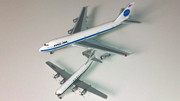
Almost unbelievable that the Boeing 747 is 45 years old and the 377 made just 20 years earlier – what a difference those two decades made! Both designs incorporated a lounge on a second deck, accessed through a spiral staircase.
Staying with Diamonds Are Forever, let’s move on to the film where James Bond swaps the BOAC Boeing 377 with a Lufthansa Boeing 707, a seemingly unlikely choice for an Amsterdam–Los Angeles flight.
This was already the third time a 707 was Bond’s mode of transport in the film series, after the Pan Am jets in DN and FRWL.
Boeing 707-300B, Lufthansa, D-ABUL “Duisburg”
Diamonds Are Forever

“Lufthansa announce the arrival of their flight LH 450 from Amsterdam”
Excerpts quoted from http://jamesbondlocations.blogspot.co.uk/search/label/Lufthansa:
“Today it is time for another post in the travel section, this time covering Lufthansa, the German airline founded in 1926. Bond, posing as diamond smuggler Peter Franks, travels to L.A. along with Tiffany Case in Diamonds are forever. Bond and Tiffany chose Lufthansa Business class for their transatlantic trip from Amsterdam. Even Mr Wint and Mr Kidd are flying on the same plane, but unlike Bond and Tiffany they fly economy. The tail number is not visible but the flight number called out onboard is LH450 to Los Angeles. Bond is arriving at LAX and the famous theme building, the landmark of Los Angeles international airport is visible in the background. The plane featured in the film is a Boeing 707-320 or 420, an airplane that was normally used for long-haul flights at the time.”
The registration is not visible but I can reveal that the DAF jet is D-ABUL, a 707-300B (also designated as -320B where 20 is Boeing’s code for their own test aircraft – so IMHO not appropriate for planes in airline livery – or -330B, 30 being the customer code for Lufthansa) built in late 1966, Boeing construction no. 19315/545.
How do I know? Below the Lufthansa lettering the name of the aircraft and the corresponding city or state crest is visible although not really legible. (Maybe it is on the Bluray and an old hat?) But the last letter left of the crest is clearly a decender, most likely a “g”, which narrows the selection down to “Hamburg” or “Duisburg” as Lufthansa’s 707s were named after large German towns. As the crest is divided horizontally it has to be Duisburg’s (black double eagle on yellow background above, white castle on red background below) and all that’s left to do is to look up the matching registration on the internet. B-)
(Well, except there were two 707-300s named Duisburg, D-ABOV and D-ABUL ... D-ABOV was built in 1962 but transferred to Lufthansa’s charter subsidiary Condor in February 1967 and then the new D-ABUL christened Duisburg.)
D-ABUL also has the distinction of being the very last 707 in Lufthansa service, after 70,175 flight hours and 18,838 landings, having carried 1.5 million passengers over a distance of 49 million kilometers (data from a January 1985 Hamburger Abendblatt article) until December 31, 1984 before being sold to Africa for a few more years in service there.
Here in all her glory, it’s easy to see that the crest is the same as above:
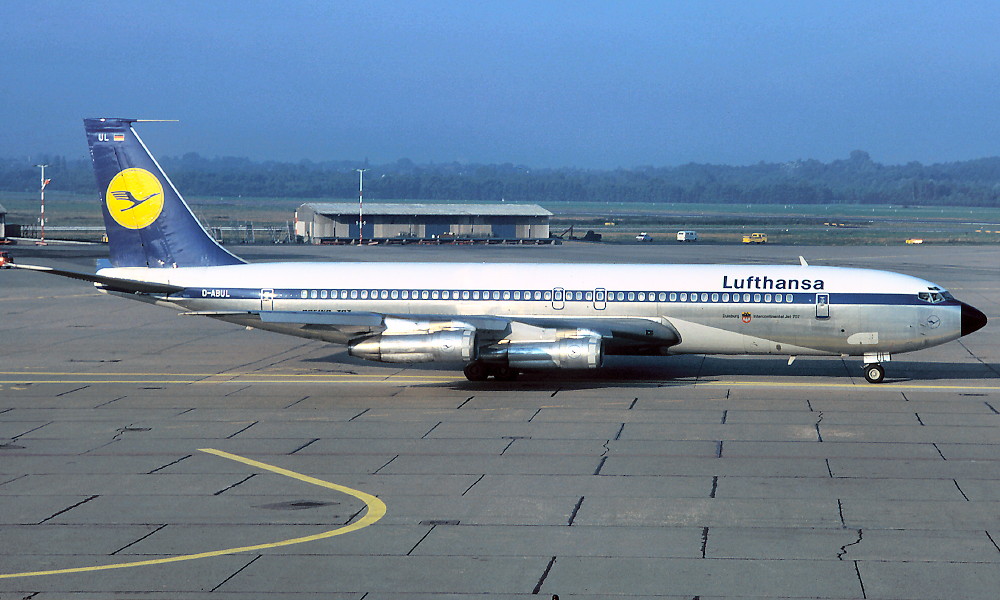
(Photo: R. N. Smith Collection – www.aussieairliners.org/b-707i/Germany/dabul.html)
“Why Lufthansa was Bond’s choice of airline is unknown. It would have been more appropriate for Bond to fly with the Dutch airline, KLM, from Amsterdam. Or Pan Am, which had already been used two times before. It is not likely that the 707 jet could fly non-stop from Amsterdam to L.A. so they would probably have to make a fuel stop on the East coast. Furthermore it is not possible, even today, to fly with Lufthansa from Amsterdam to L.A. The only non-stop Lufthansa flight from Europe to L.A. departs from Frankfurt.”
So, why Lufthansa instead of KLM or Pan Am? This is easily answered nowadays: KLM didn’t fly to U.S. destinations west of Chicago and Houston (except Anchorage which, from Amsterdam, is indeed not west of Chicago, as it is reached in northeastern direction on the polar route).
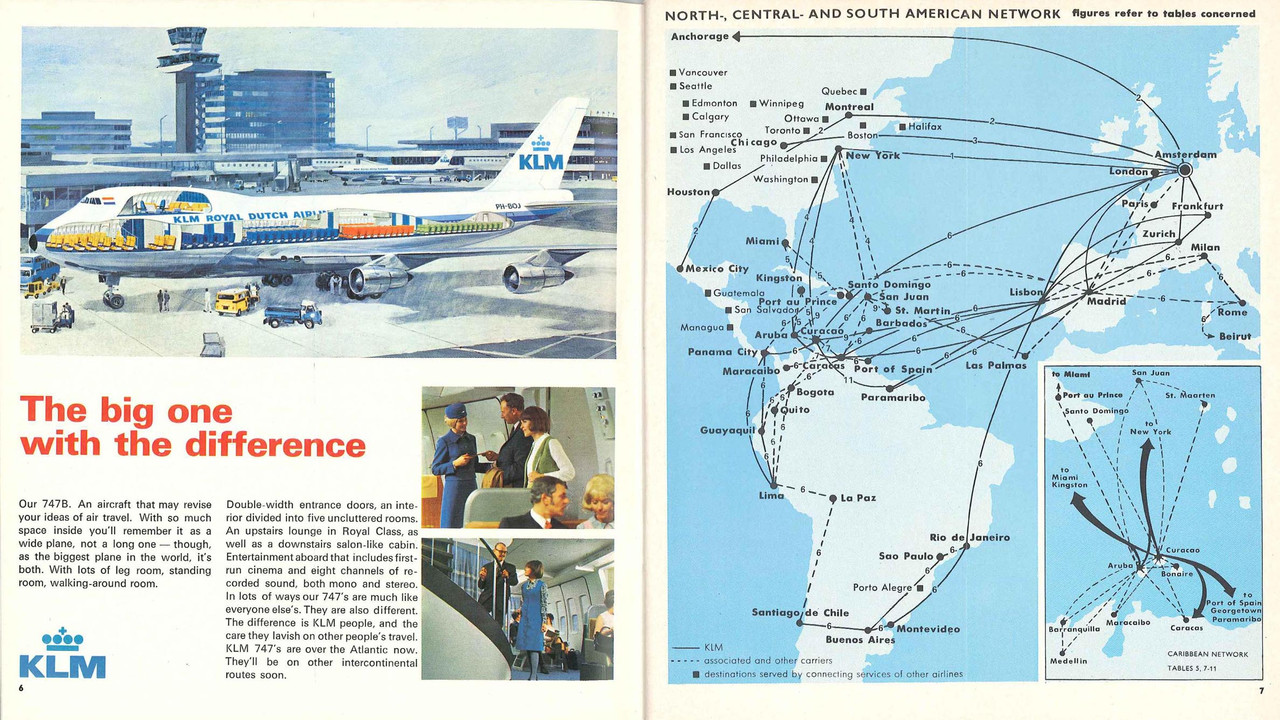
(KLM timetable May 15, 1971 – www.timetableimages.com/ttimages/kl/kl71/)
Pan Am never flew directly from Amsterdam to L.A., one would have to change planes in London – but Lufthansa did offer direct (but not always non-stop) flights – the familiar sounding LH 450!
Boeing 707, departing Frankfurt Wednesday at 13.15, Amsterdam arr 14.10/dep 14.55, intermediate stop in Montreal from 16.25 to 17.20, arr LAX 20.00. That was in 1970.

(Lufthansa timetable April 1, 1970 – www.timetableimages.com/ttimages/lh/lh70/)
In 1972 it was a little different as Montreal was no longer an intermediate stop on LH 450 (but on LH 454). LH 450 was now tri-weekly (Monday, Wednesday, Sunday), still served with the 707: FRA dep 13.25, AMS arr 14.25/dep 15.10, LAX arr 18.50. Non-stop flights FRA–LAX were not possible with the 707 and were not offered until May 1977 when Lufthansa replaced the 707 with the 747 on this route. However, the one hour less flying time from AMS brought LAX well within the range of the 707-300B – the Montreal stop was not necessary for refueling.
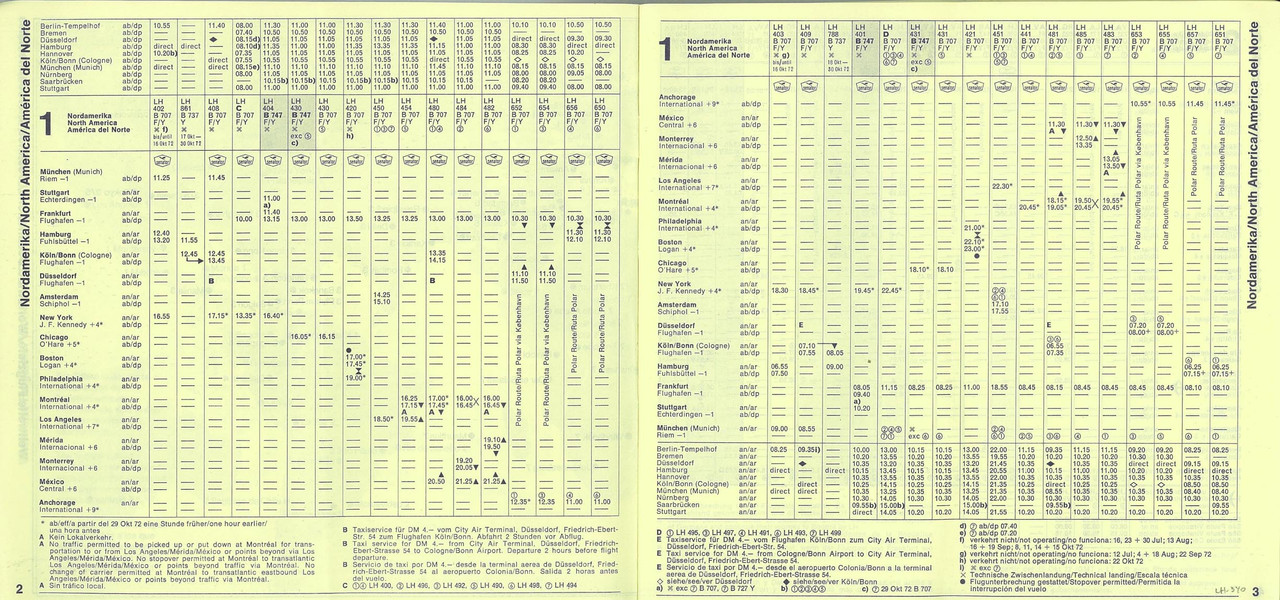
(Lufthansa timetable July 1, 1972 – www.timetableimages.com/ttimages/lh/lh72/)
I don’t know which of the two schedules was in effect at the time of filming but LH 450 clearly seems like the best option to fly from Amsterdam to L.A. then, with or without the extra stop in Montreal. I would guess that because of this Lufthansa was approached by Eon to provide transport for crew and equipment between the two cities, and they were happy to do so as long as Lufthansa was clearly visible in the film. Well done, using the real flight number LH 450 here, although I would think a real Lufthansa announcement at LAX would also mention Frankfurt and not just Amsterdam.
The model: Boeing 707-300B, Lufthansa, D-ABUL “Duisburg”
AeroClassics ACDABUL, 1:400
This model was one of several in Lufthansa livery released in 2014 in a quantity of 360 pieces. It is a special model as it is one of just a few with the same registration and livery as in the film. It can still be found on ebay.
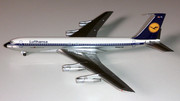
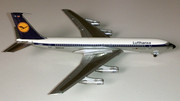
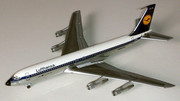
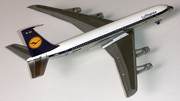
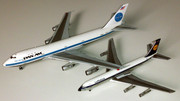

Yes, both are the same scale. It’s still amazing how even a grown-up jet like a 707 is dwarfed by the 747. You can imagine the sensation the Jumbo Jets caused in 1970 when the first arrived at the airports.
ATL-98 Carvair, British United Air Ferries, G-ASDC “Pont du Rhin”
Goldfinger
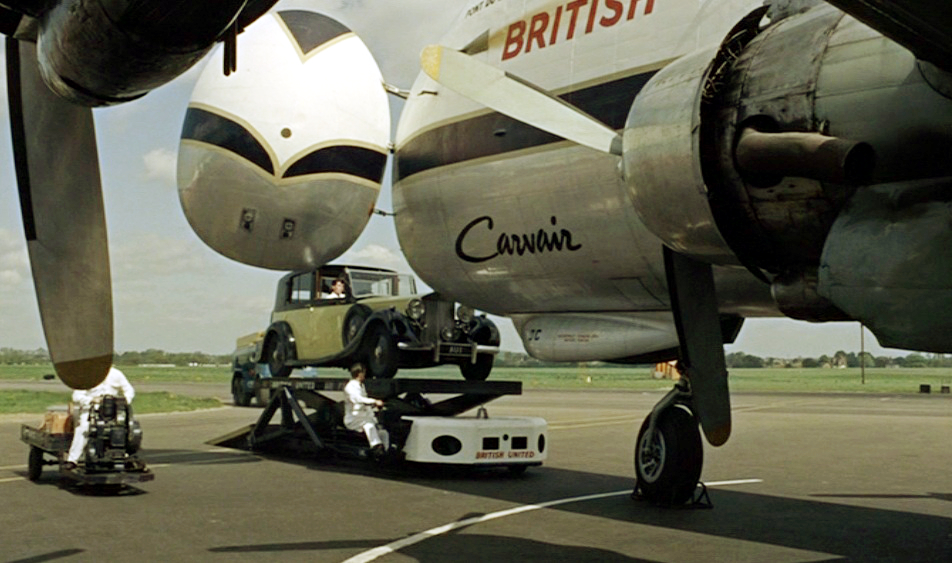
“British United Air Ferries announce the departure of their VF 400 flight to Geneva”
Quoted from http://jamesbondlocations.blogspot.co.uk/search/label/British%20United%20Air%20Ferries:
“Some of the posts in the travel section featuring Bond’s airlines of choice are often the most popular, and they are also very fun to write. So, to celebrate the week-end I give you an airline from the 60’s. Goldfinger is flying to Genève with British United Air Ferries in 1964 along with his golden Rolls Royce. Bond gets on the next plane and shadows Goldfinger across Switzerland.
Crossing the channel from England by sea was usually a time consuming business and that is why the so called “air ferries” emerged in the 40’s and 50’s. They transported cars and their owners across the channel to various parts of the continent. Bond and Goldfinger are flying from “London Southend airport” at Southend-on-Sea.
The reason why British United Air Ferries was Goldfinger’s choice for airline shows the amazing details and quality that went into the earlier Bond films and the producers efforts to be as faithful as possible to the original novel. In the novel, Bond is told that Goldfinger will fly with Silver City Airways across the channel. Silver City was an airline that was in operation when Fleming wrote Goldfinger in 1958 and obviously something that the filmmakers wanted to use in the film. But the problem was that this airline had ceased operations in 1963, and was not avaliable for the film. But they had merged with Channel Air Bridge to form the new airline: British United Air Ferries! So it is in a way Fleming’s ultimate choice that was used in the film.
The plane that looks similar to a Boeing 747 is in fact an Aviation Traders ATL-98 Carvair, a model that was based on the Douglas DC-4.
Loaded at the front it had a capacity of 3–5 cars and approx. 25–50 passengers. The plane was developed by Aviation Traders (Engineering) Limited – ATL, and the name Carvair was derived from car-via-air.
One of the first planes originally used by Silver City Airways, the Bristol freighter, had a capacity of 1–2 cars and rather high operating costs, for example if a booked car failed to show up. And as the traffic increased so did the length of British cars and the demands for new planes. The Bristol freighter/superfreighter with its limited payload proved to be inadequate in the late 50’s. That’s when the converting of the DC-4 proved to be a relatively inexpensive solution. In the mid 70’s the Carvair planes were transferred for cargo flying and on 1 January 1977 the airline operated its last car ferry service. Following several name changes (British Air Ferries and British World Airways) and ownership changes, the airline went out of business in December 2001, following the post 9/11 downturn.”
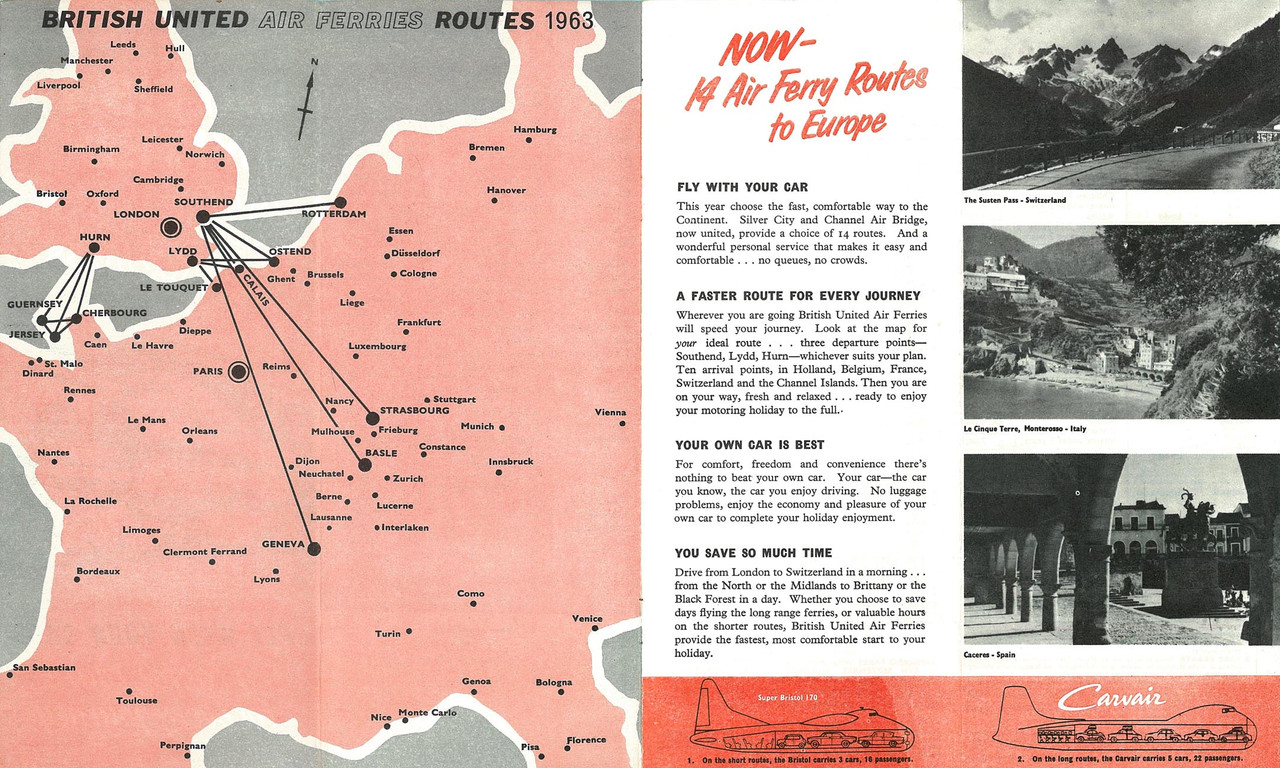
The Carvair could carry 5 cars and 22 passengers. With a payload of 8,770 kg and taking into account that a Rolls-Royce Phantom III weighed in at about 2,800 kg without the 18-carat gold bodywork it was quite a gamble to take the plane instead of the ferryboat. Goldfinger was pushing his luck with his frequent flights but it seems that all the other passengers were rather skinny and drove lightweight cars.
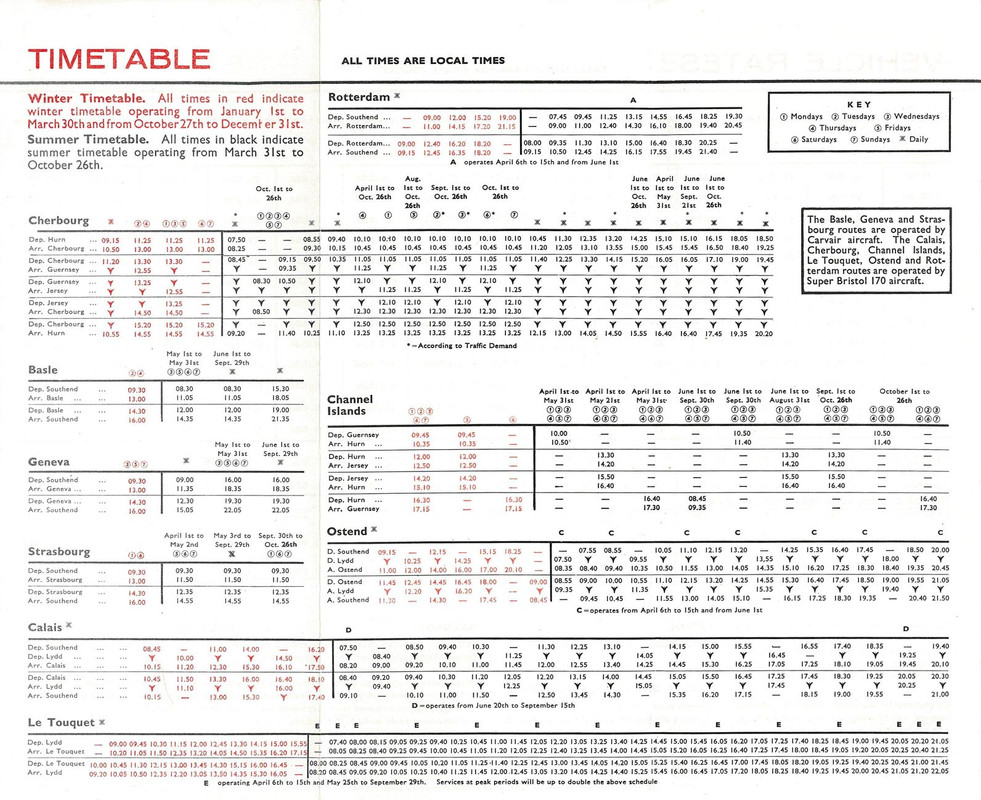
(British United Air Ferries timetable January 1, 1963 – www.timetableimages.com/ttimages/complete/vf63/)
In 1963 two daily flights from Southend to Geneva at 9.00 and 16.00, so it’s a bit of artistic licence that another plane would follow Goldfinger’s just half an hour later. I can’t confirm the mentioned VF 400 as this timetable shows no flight numbers. But as VF was the official flight designator for British United Air Ferries and the Southend–Geneva flight existed in reality I have no reason to doubt the flight number. The next timetable from 1966 shows two Geneva flights, VF 401 and 402, but not at 9.00 which probably was VF 400.
Fare Southend–Geneva in 1963: £17 4s., return £32 14s.
plus, depending on car length, £32 for the Phantom III or £21 10s. for the DB5
Addendum: Goldfinger’s Carvair G-ASDC, then operated by Hondu Carib Cargo with number N103, crashed in June 1997 in Alaska after an engine fire and an emergency landing in the Chandalar River. Both pilots survived with only light injuries, and the Carvair wreck is still visible on the river bank.
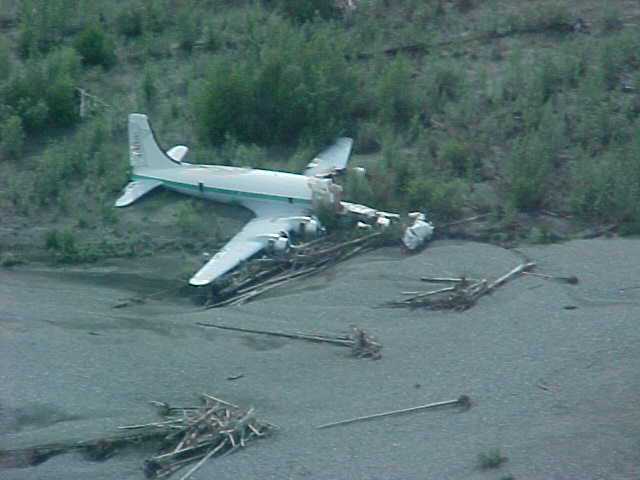
(Photo: http://www.weirdgoogleearth.com/n103-crash-site/)
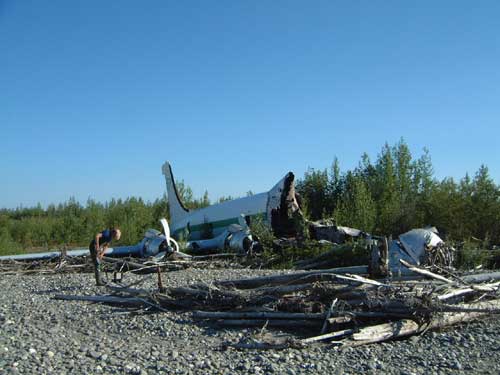
(Photo: http://www.angelfire.com/de/kanualaska/markusheiko.html)
The model: ATL-98 Carvair, British United Air Ferries, G-ARSD “Chelsea Bridge”
JC Wings JC4023, 1:400
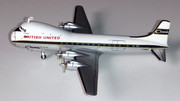
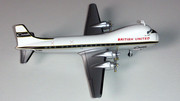
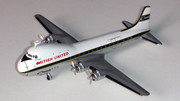
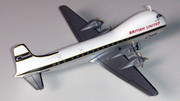
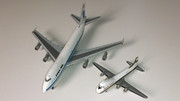
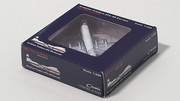
Goldfinger is boarding G-ASDC but a second ATL-98 is seen behind it and will follow on the same route. The other registration is not visible but let’s pretend it was G-ARSD.
Vickers Viscount 700, BEA
From Russia with Love novel
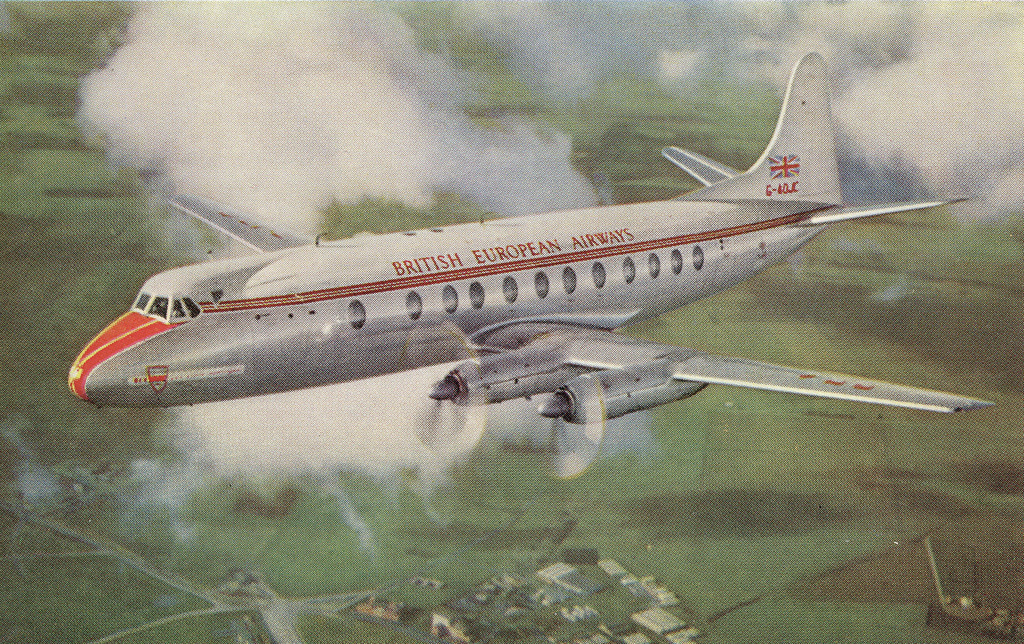
“The four small, square-ended propellers turned slowly, one by one, and became four whizzing pools. The low hum of the turbo-jets rose to a shrill smooth whine. The quality of the noise, and the complete absence of vibration, were different from the stuttering roar and straining horsepower of all other aircraft Bond had flown in. As the Viscount wheeled easily out to the shimmering east-west runway of London Airport, Bond felt as if he was sitting in an expensive mechanical toy.
There was a pause as the chief pilot gunned up the four turbo-jets into a banshee scream and then, with a jerk of released brakes, the 10.30 B.E.A. Flight 130 to Rome, Athens and Istanbul gathered speed and hurtled down the runway and up into a quick, easy climb.
In ten minutes they had reached 20,000 feet and were heading south along the wide air-channel that takes the Mediterranean traffic from England. The scream of the jets died to a low, drowsy whistle”
“How old is this plane, he wondered? How many flying hours has it done? Had the deathwatch beetle of metal fatigue got into the wings? How much of their strength had it eaten away? Perhaps he wouldn’t get to Istanbul after all. Perhaps a plummeting crash into the Gulf of Corinth was going to be the destiny he had been scanning philosophically only an hour before”
“They had only a ninety-minute flight to Istanbul, across the dark Aegean and the Sea of Marmara”
– Ian Fleming, From Russia with Love (1957)
The Griswold chronology places the FRWL novel from June to August 1954 and the BEA (British European Airways) flight on Friday, August 13; Chancellor’s chronology in 1955.
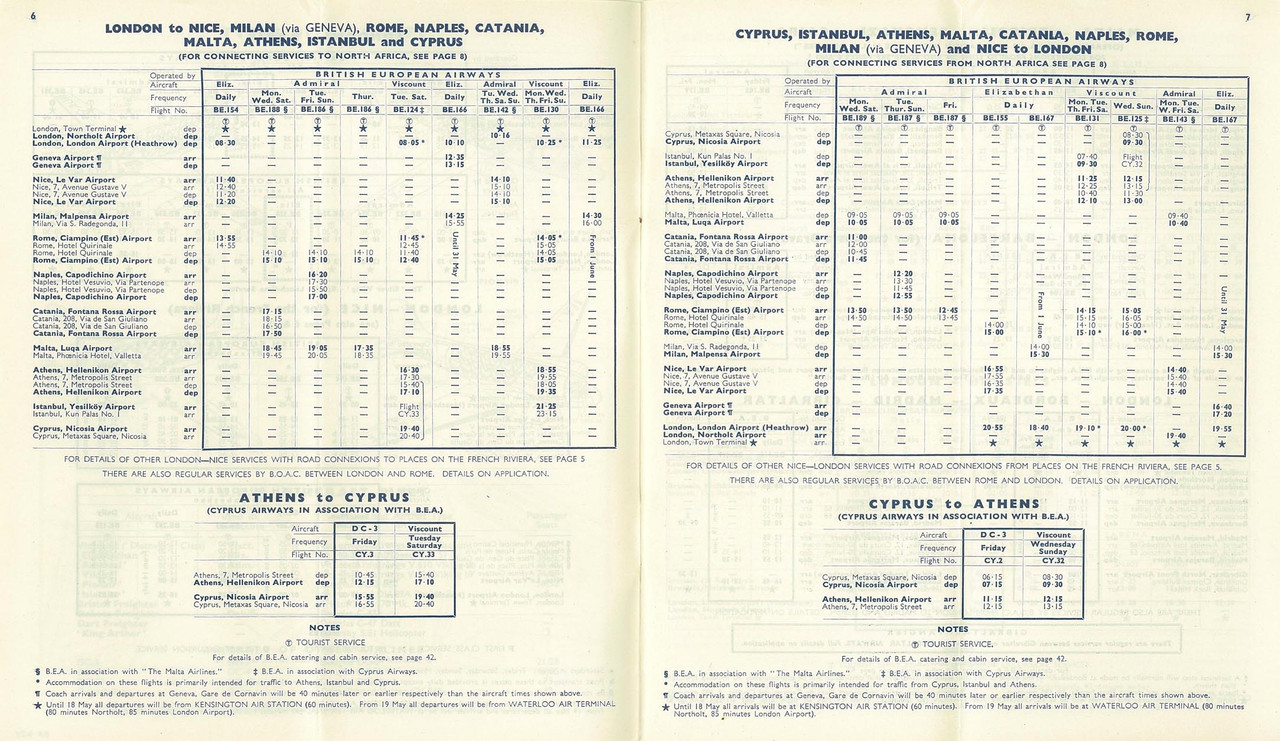
(BEA timetable April 19, 1953 – www.timetableimages.com/ttimages/be/be53/)
The 1953 timetable provides a (near) perfect match, with only a 5 min earlier departure time: BE 130 with Viscount aircraft, departing Heathrow every day except Tuesday and Saturday 10.25, Rome Ciampino arr 14.05/dep 15.05, Athens Hellenikon arr 18.55/dep 19.35, Istanbul Yesilköy arr 21.25.
Fare London–Istanbul in 1953: £61 10s., return £110 14s.
The next available BEA timetable from 1958 still lists BE 130 with Viscounts, although with a departure at 10.15.
The Vickers Viscount 700 was the world’s first turboprop aircraft in scheduled service. A turboprop uses a gas turbine to drive a conventional propeller instead of propulsion through the turbine’s exhaust gases as in a jetliner. And while it used the same technology as a jet, the appearance was that of a propliner which, combined with the jet’s higher speed, soon led to the turboprop as being viewed as outdated by the public.
The Viscount was introduced with BEA in April 1953. The enlarged Viscount 800 series arrived in February 1957, so Bond’s aircraft has to be a 700. With 445 built, the Viscount is one of the most successful British civil aircraft designs, although it was also involved in a significant number of accidents. BEA lost three Viscounts in 1957 alone.
The model: Vickers Viscount 700, BEA, G-AMOA
AeroClassics ACGAMOA, 1:400
The AeroClassics Viscount is one of the older moulds from this producer and suffers from the obvious seam line between wings and fuselage although it captures the shape of the aircraft well. No square-ended propellers, though. It also shows the vertical oval windows and unusual oval doors of the 700 (the 800 changed back to conventional rectangular doors).
AeroClassics recently (2013/14) released several BEA versions and G-AMOA was the one in the delivery scheme from 1953, used until the 1960s when it was superceded with the black-white BEA Red Square livery. This model can still be found easily.
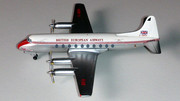
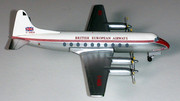

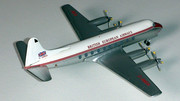
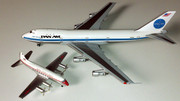
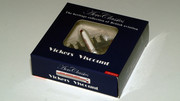
G-AMOA was one of the first Viscounts delivered to BEA in 1953 and was damaged beyond repair on January 19, 1970 in a heavy landing at Bristol airport, at the time operated by Cambrian Airways. There were no casualties.
Sud Aviation SE-210 Caravelle III, Swissair
On Her Majesty’s Secret Service novel
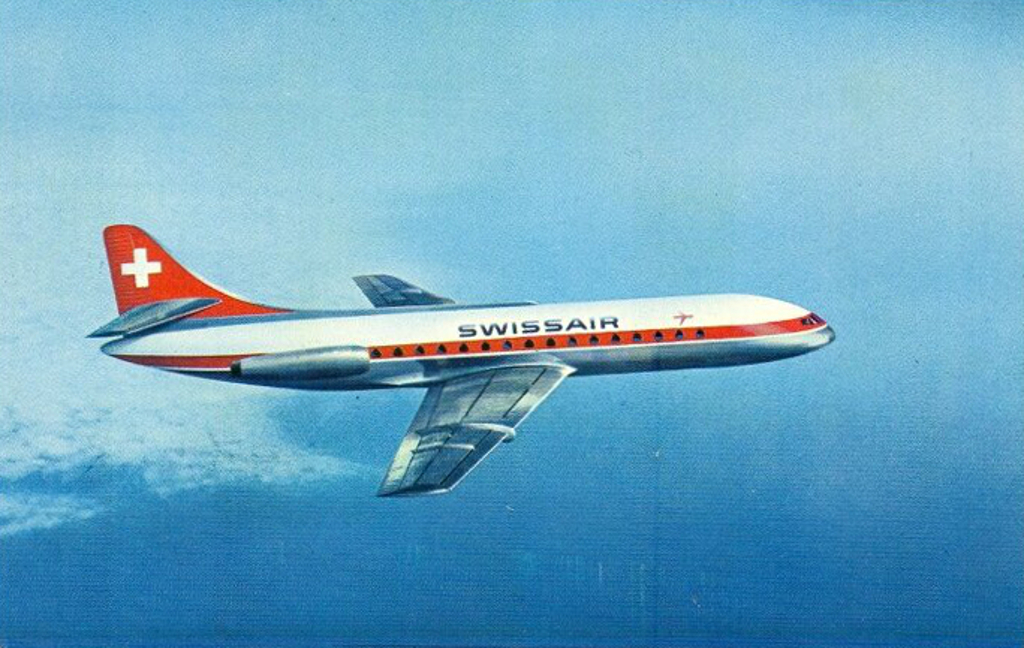
“And, sure enough, the next day came a letter from Zürich to say that their client agreed to a meeting with Sir Hilary. Would Sir Hilary please arrive at Zürich Central Airport by Swissair Flight Number 105, due at Zürich at 1300 hours on December 21st”
“Then, with its twin jets whispering far back of the first-class cabin, the Swissair Caravelle was airborne”
“In the grey dawn, Zürich airport was depressing and almost deserted, but, blessedly, there was a Swissair Caravelle, delayed by fog at London Airport, waiting to take off for London.”
“Attention, please. Passengers on Swissair Flight Number 110 for London, please assemble at gate Number 2”
– Ian Fleming, On Her Majesty’s Secret Service (1963)
The Caravelle was the world’s first jet airliner for short and medium distances, entering service shortly after the long-range types Comet 4 and Boeing 707 in 1959, and was the first with the engines placed on the rear of the fuselage instead of the wings, thereby reducing interior noise and vibrations. 282 Caravelles were built; 78 of those were the Caravelle III variant which was the one operated by Swissair.
As the cause for the De Havilland Comet 1 crashs was determined to be fatique stress originating from the Comet’s rectangular windows, Sud Aviation designed triangular windows with rounded corners. This feature remained unique to the Caravelle.
Swissair operated Caravelles from 1960 to 1971. In September 1963, half a year after OHMSS was published, Swissair Caravelle HB-ICV “Schaffhausen” crashed shortly after take-off from Zürich, killing all 80 people on board.
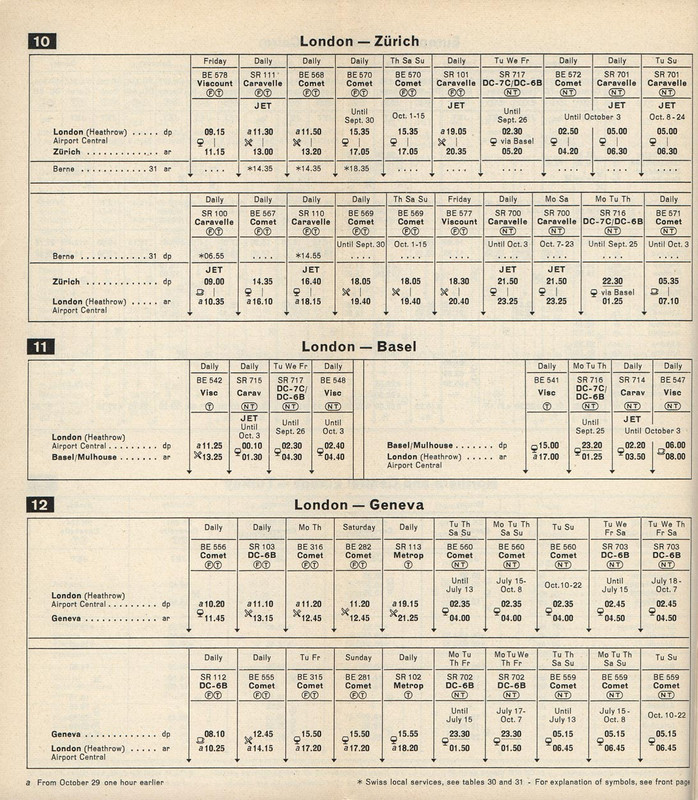
(Swissair timetable July 1, 1961 – www.timetableimages.com/ttimages/sr/sr61/)
Griswold’s chronology places OHMSS in 1961/62, and the July 1961 Swissair timetable shows Bond’s return flight SR 110: daily flight with Caravelle, departing Zürich 16.40, arriving London 18.15.
There is no flight 105 although one London–Zürich flight arrives at 13.00: SR 111, departing London 11.30, arriving Zürich 13.00.
Though flight 105 can be found in 1960, the first year of Caravelle service:
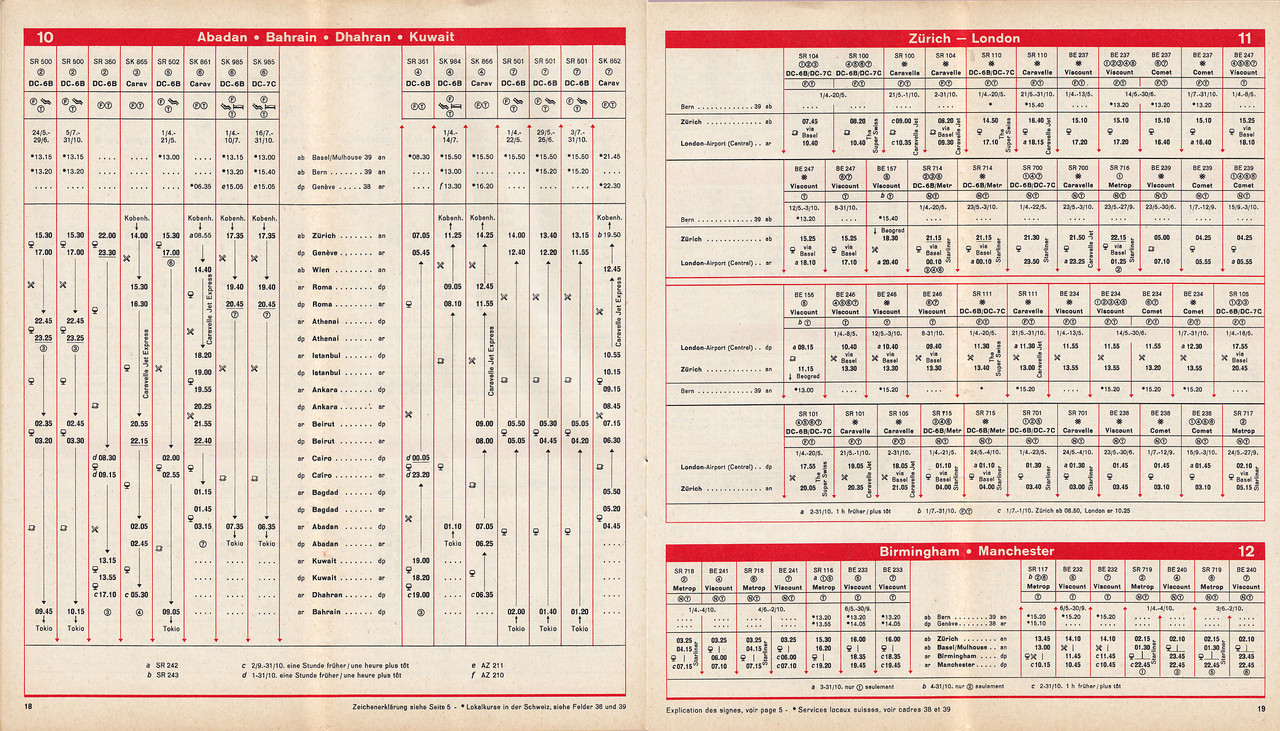
(Swissair timetable April 1, 1960 – www.timetableimages.com/ttimages/sr/sr6004/)
SR 105 with Caravelle, departing London 18.05, arriving Zürich 21.05.
But, except for the flight number, SR 111 is the one matching Fleming’s description:
departing London 11.30, arriving Zürich 13.00.
The model: Sud Aviation SE-210 Caravelle III, Swissair, HB-ICY “Lausanne”
AeroClassics (for Tucano Switzerland) 18010, 1:400
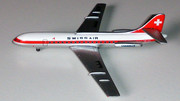
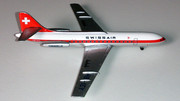
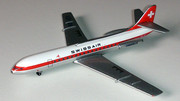
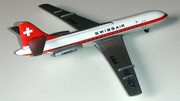
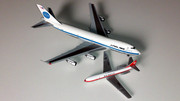
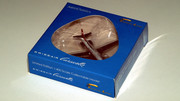
The box repeats the Caravelle’s signature triangular window design.
The Caravelle III, although a very early AeroClassics mould, is a very nice model and still holds up well. HB-ICY was released in May 2002 as an exclusive production for Tucano-Line. As Bond was met by Fräulein Irma Bunt at Zürich airport, the icy registration is quite fitting. In 2011 AeroClassics produced another Swissair version, HB-ICS, in the same 1960s livery.
Edit: catched a few typos and added name and fate of Carvair G-ASDC
And then I began to collect James Bond planes, just seen for a few seconds ... ;%
It all began about a year ago when I viewed a Corgi Drax helicopter on ebay and one of the “similar items” shown at the bottom was a 1:400 scale Lockheed Electra in Drax Air Freight livery. As it was one of a limited edition of only 120 pieces for a certain “Hangar Club” I decided to bid and won it for about $40.

After receiving the packet I was very disappointed as it was much smaller than I had expected. From the details of propellers and landing gear and the neat tampoprints I had thought that the plane would be quite a bit larger. I guess the “1:400” part of the description should have told me something ...
Actually, 1:400 is a popular scale for collectors of airliners, and when you have a modern jet in hand it is a well-chosen scale as such planes in 1:200 are consuming too much space to collect a fleet. It is just that the older airliners like the Electra were so much smaller than today’s and for such small aircraft the larger scales 1:200 or 1:144 are probably better suited unless, of course, one prefers a fleet in a consistent scale. Committing to 1:400 scale also means a restriction to airliners or large military aircraft as small fighters or helicopters aren’t made in this scale.
Although disappointed at first I have come to like this tiny model and after having my first 1:400 plane in the collection I looked if any other, more memorable Bond-connected aircraft had been produced in the same scale. I didn’t expect the “Skyfleet S570” from CR as this would need an extensively modified 747 mould not reuseable for anything else – but something like the 747 shuttle carrier in Moonraker livery or the DC-3 from QoS, using already existing moulds with just a different decoration. I don’t think it would be too difficult to sell 120 pieces of those worldwide, the usual quantity for the Hangar Club models. Although other fantasy aircraft – like the Boeing 707 from Airport and the 747 from Airport ’75 – have been released as Hangar Club models, unfortunately no other Bond models exist in 1:400. (Other scales aren’t any better, with the Drax Electra not even available in any other scale.)
Having looked up the different aircraft that have featured in the Bond films, ranging from the once-ubiquitous 707 to the exotic ATL Carvair, I tried to find models in the same period livery, and in a few cases even a model with the same registration can be found. I also decided later to add the planes from the Fleming novels which include illustrious names like the Stratocruiser, Caravelle and the iconic Super Constellation.
I searched for info about the prototypes on sites like airliners.net, the International Movie Plane Database impdb.org or the James Bond Locations blog jamesbondlocations.blogspot.co.uk and also enjoyed trying to find the mentioned flights in old timetables; in passing answering such age-old questions like “Did Pan Am flight no. 1 really go from London to Istanbul?” or “Why take Lufthansa from Amsterdam to L.A. instead of KLM?”. The essential resource for this was timetableimages.com. So instead of just showing some photos of tiny toy planes I will also add some info about the prototypes and the appropriate timetables.
As I am still looking for some models from films and novels, including a Pan Am 707 from the first two films, I’ll start with the one “real” James Bond collectible and then continue in no particular order, and if anyone is interested there will be more instalments in the future.
Lockheed L-188 Electra, Drax Air Freight (Varig), PP-DRX
Moonraker

Excerpts quoted (with kind permission) from jamesbondlocations.blogspot.co.uk/search/label/Varig%20Brazil. -{ I am only quoting the passages concerning the aircraft and airlines but not the locations parts about the airports, so I can only recommend visiting the site:
“In Moonraker Bond goes to Rio to investigate the affairs of Hugo Drax. In a warehouse belonging to the importer firm ‘C&W’ (Carlos & Wilmsberg) in downtown Rio, Bond learns that Drax is moving his merchandise through his cargo airline ‘Drax Air Freight’. Manuela tells Bond that ‘Drax Air Freight’ operates out of San Pedro Airport and Bond gets up to the Sugarloaf mountain to check it out.
The airport can be seen from the viewpoint on top of the mountain, no doubt one of the most famous tourist attractions in Rio. In reality the airport is called Santos Dumont Airport, after a Brazilian aviation pioneer. Why San Pedro was used instead of the real name is unclear.
The Drax Air Freight plane however is a Lockheed L-188 Electra, in reality belonging to Varig Airways, the leading Brazilian airline at the time. The dark blue plane livery can be recognized if you compare Drax’s plane with the Varig plane in the picture below. Santos Dumont airport was one of the main airports that Varig used in Brazil. In 1959 together with two other airlines, Varig had initiated an “air shuttle service” between Rio-Santos Dumont airport and São Paolo airport. The three airlines coordinated their schedules and operations and shared their revenue. Due to the success of this shuttle service led by Varig, it was abandoned only in 1999. The interesting fact is that this route was served exclusively by Varig’s Lockheed L-188 Electra between 1975 and 1992 and the aircraft used on this route did not have the Varig name on the fuselage for the sake of neutrality to the other two airlines. This would have made it easy for the filmmakers to use one of Varig’s aircraft in the film and put the name “Drax Air Freight” on the side, since the fuselage didn’t have the Varig logo on it.
The Lockheed L-188 was developed in the 1950’s by the American manufacturer Lockheed. It first flew in 1957 and was the first large American turboprop airliner. However, the engines would soon be replaced by turbojets and many of the aircraft that still used this engine type were modified as freighters.
Varig was the leading and almost only international airline in Brazil between the years 1965 and 1990. Beginning with the new millennium, Varig experienced financial difficulties and after a reconstruction and two failed attempts to auction the airline, Varig was split into two companies. The call sign ceased to exist in 2008.”
Maybe worth adding is that while the Electra was not the success Lockheed had hoped for, the U.S. Navy variant P-3 Orion was, with 650 built and one of only a few aircraft types with more than 50 years of service with U.S. armed forces.
The model: Lockheed L-188 Electra, Drax Air Freight, PP-DRX
AeroClassics, Hangar Club HC-002, 1:400
This was released in 2003 or 2004 as the second exclusive model for members of the Hangar Club of which I don’t know much about. I have seen a few of their exclusive models but no other James Bond models were made. The Electra comes in a white box without model identification but with an individually numbered collector card.





The AeroClassics Electra is nicely done but the Drax Air Freight typeface is different to the one used on the real plane. AeroClassics seems to have used the sans-serif font used by Varig but the Drax Air Freight was painted on with a serif font similar to Excelsior. It could be that the colour was black rather than Varig blue. The nose is clearly shorter than in the photo but it is possible that the real plane AeroClassics used as a prototype for their Electra mould had a different shape than Varig’s plane as later installed radar equipment often necessitated the alteration of the nose. The model manufacturers often make just one mould for many variations, and the decision left to collectors is to accept some differences or not get a desired model at all. Window and door configurations often match very well as those are only printed onto the fuselage, there are no inset windows.
Just to give a sense of scale – here with the Corgi helicopters which will be familiar to many and are about 1:64 and 1:128 for the Junior.

And here with a 747 for a size comparison. I will use this with every model as most of you can imagine the size of a 747 but few will have seen a Lockheed Electra, Vickers Viscount or Boeing 377 in real life before. All models I show are to the same scale, 1:400.

As I am still looking for a 707 from DN and FRWL, I continue with an interesting prototype from the novels – the Boeing Stratocruiser which was guest-starring in several of Fleming’s books:
Boeing 377 Stratocruiser, BOAC
Live and Let Die novel
Diamonds Are Forever novel
Goldfinger novel
For Your Eyes Only short story
007 in New York short story

“From the moment the B.O.A.C. Stratocruiser taxied up to the International Air Terminal at Idlewild, James Bond was treated like royalty”
– Ian Fleming, Live and Let Die (1954)
“... and then they were all walking across the tarmac and up into the big Boeing and, with a burst of oil and methanol smoke, the engines fired one by one. The chief steward announced over the loudspeaker that the next stop would be Shannon, where they would dine, and that the flying time would be one hour and fifty minutes, and the great double-decker Stratocruiser rolled slowly out to the east–west runway. The aircraft trembled against its brakes as the Captain revved the four engines, one at a time, up to take-off speed, and through his window Bond watched the wing flaps being tested. Then the great plane turned slowly towards the setting sun, there was a jerk as the brakes were released and the grass on either side of the runway flattened as, gathering speed, the Monarch hurtled down the two miles of stressed concrete and rose into the west, aiming ultimately for another little strip of concrete carpet on the other side of the world”
– Ian Fleming, Diamonds Are Forever (1956)
“Will Mr James Bond, passenger on B.O.A.C. Monarch Flight No. 510 to Gander and London, please come to the B.O.A.C. ticket counter”
“The theft of a Stratocruiser, as Goldfinger had explained it, was preposterous, but no more so than his methods of smuggling gold”
“This is Ocean Station Charlie calling Speedbird 510. Charlie calling G-ALGY. Can you hear me? Come in Speedbird 510”
“... when the belly of the Stratocruiser had thudded into the first mountain of swell at a hundred miles an hour. The huge plane skipped once and then crashed nose first into a wall of water. The impact had broken the back of the plane”
– Ian Fleming, Goldfinger (1959)
“Two days later, Bond took the Friday Comet to Montreal. He did not care for it. It flew too high and too fast and there were too many passengers.
He regretted the days of the old Stratocruiser – that fine lumbering old plane that took ten hours to cross the Atlantic. Then one had been able to have dinner in peace, sleep for seven hours in a comfortable bunk, and get up in time to wander down to the lower deck and have that ridiculous B.O.A.C. ‘country house’ breakfast while the dawn came up and flooded the cabin with the first bright gold of the Western hemisphere. Now it was all too quick”
– Ian Fleming, For Your Eyes Only (1960)
“It was just 10 a.m. on a blue and golden late September morning and the B.O.A.C. Monarch Flight 505 from London had landed at Idlewild”
– Ian Fleming, 007 in New York (1963)
Although I’ve been interested in aviation history since I was a child I had never heard of the Boeing Stratocruiser before I looked for the Bond aircraft. The B377 was one of the last airliner developments with piston engines to enter service, in 1949, and as such was seen as the end of an era. Every major manufacturer was already working on turbine-powered successors in either jet or turboprop form, with the first jetliner (the ill-fated Comet 1) following just three years after the B377.
The Stratocruiser was the civilian version of the U.S. Air Force C-97 freighter, itself an enlarged B-29/B-50 bomber from which the Stratocruiser inherited the rounded nose, Wasp Major engines, wings and tailfin. The latter was so high that it could be folded sideways to fit into the existing hangars.

The Stratocruiser was a double-deck design and offered a “comfortable lower-deck lounge, with its well-stocked bar and gay, convivial atmosphere” and unprecedented luxury on the main level, including sleeping berths and, with some other airlines, even a private sleeping room in the tail section. In first-class configuration as used on the BOAC Monarch flights it accommodated less than 40 passengers.
Powered by four 28-cylinder radial engines each developing 3,500 hp, those massive engines and the propellers were the source of many problems, and it was obvious that a piston engine would not reliably provide yet more power for the larger aircraft then on the drawing boards. The Stratocruiser was plagued with in-flight engine fires, loose propeller blades or even whole engines falling off the wings after the engine mounts broke.
There were ten fatal crashs involving Stratocruisers during the 1950s; BOAC lost one on Christmas Day 1954 at Glasgow-Prestwick, killing 28 of the 36 on board.
BOAC used the type from 1950 till 1959. All in all, the Stratocruiser was expensive to buy and operate, and was a commercial failure for the airlines, and for Boeing which built only 56. However, its advanced fuselage construction principles were later successfully applied to the 707. Some Stratocruisers were later converted to Guppy freighters for oversize loads, like parts of the NASA Saturn rockets.
Ian Fleming mentions two flight numbers: “B.O.A.C. Monarch Flight 505 from London had landed at Idlewild” in the 007 in New York short story, and “B.O.A.C. Monarch Flight No. 510 to Gander and London” in Goldfinger.
According to John Griswold’s fictional James Bond chronology (en.wikipedia.org/wiki/List_of_James_Bond_novels_and_short_stories#Fictional_chronologies) Goldfinger is set from April to June 1957, and 007 in New York in late September 1961. The luxury Monarch service was introduced in 1951 on the London–New York route only for a single Stratocruiser flight pair but in later years the name was also used on other aircraft like the Douglas DC-7, Bristol Britannia, De Havilland Comet 4 and Boeing 707.
So, off to www.timetableimages.com, to the list of complete timetables, and we find a BOAC one from April 14, 1957; should be perfect for Goldfinger:

(BOAC timetable April 14, 1957 – www.timetableimages.com/ttimages/ba2/ba57/)
In Table 4 we find flights BA 510S (Stratocruiser) and BA 510 (DC-7C) and read that DC-7s are used until May 1st, with Stratocruisers resuming service from May 2nd. I guess that the newer DC-7s were employed during the winter season in the later years of Stratocruiser service. (If the timetable is too small to read then open in a new tab, as the large scans are automatically reduced to frame width on this site.)
BA 510S, Stratocruiser, Monarch flight, departing New York daily 17.00 (that’s 5 p.m.
The Gander stop is not shown in the table as this was only a technical stop for refueling. Fleming’s text checks out fine, except no BOAC Stratocruiser carried the registration G-ALGY.
The search for BOAC Monarch flight 505 was a bit more difficult. In the August 1961 timetable we find several Monarch flights (all with 707 jets by then), including the venerable ex-Stratocruiser numbers 501 and 509. But no 505.
After going back a few years I found flight 505 in the 1950 and 1951 timetables:

(BOAC timetable July 1, 1950 – www.timetableimages.com/ttimages/ba2/ba5007/)
1950 was before the introduction of the Monarch service, so the later Monarch flights 509/510 are shown as “ordinary” first-class flights though the mentioned sleeper berths were already available for an “additional charge of U.S. $25 or Can. $27.50 (£8 19s. 0d.)”.
(By 1957 the charge for a berth had risen to U.S./Can. $75/£26 16s.)
BA 505, departing London on Sunday/Wednesday/Friday 20.00, Shannon arr 22.00/dep 23.00, Gander arr 4.50/dep 5.50, New York arr 8.35 (or 9.35 daylight saving time as it was a “late September morning”).

(BOAC timetable July 1, 1951 – www.timetableimages.com/ttimages/ba2/ba51/)
1951 shows the new Monarch flights (509/510). BA 505 was no Monarch flight (but still: this was all-first class, so maybe the cause for confusion), departing London (Tuesdays only) at 18.00, Shannon arr 20.00/dep 21.00, Boston arr 5.50 DST/dep 6.50 DST, New York arr 8.00 DST.
This timetable also shows fares: London–New York cost £133 19s., return £241 3s.
A 1952 timetable is not available but in 1953 flight no. 505 is no longer listed. As 007 in New York was published in 1963 and is allegedly set in September 1961, this seems like an awfully old timetable Fleming used when writing the story. As he was a frequent flyer between London and Jamaica I can’t imagine him having a ten year old BOAC timetable lying around. Could it be that this short story was written much earlier?
I don’t think that 505 is just a typo and Fleming meant the real Monarch flight BA 509 – he also mentions “the Monarch” in DAF but describes the stop at Shannon airport not made by the Monarchs (those were direct flights with only a fuel stop in Gander, Newfoundland).
BA 505 looks like the perfect match for the DAF flight but this conflicts with the fictional chronologies: John Griswold places DAF in July 1953; and Henry Chancellor in 1954 – the Stratocruiser flights to New York with intermediate stops (BA 507/513/515) were routed via Glasgow-Prestwick, not Shannon, in those years.
The model: Boeing 377 Stratocruiser, BOAC, G-AKGH “Caledonia”
AeroClassics ACGAKGH, 1:400





G-AKGH was delivered to BOAC in November 1949, in a bare-metal finish. It was soon repainted in this livery with white top and tailfin and blue cheatline (the ungainly Stratocruiser could well use one). G-AKGH was part-traded back to Boeing in 1958 when BOAC ordered 707s. Also in 1958 BOAC repainted a few Stratocruisers with a blue tailfin as introduced on the new Comet 4. The AeroClassics Statocruiser was produced in 2009 in two BOAC versions, the white tail “Caledonia” and the blue tail “Cabot” G-AKGL, both as an edition of 360 pieces, the standard quantity for all AeroClassics releases.
For the Fleming novels the earlier livery is the more appropriate.
I tried to straighten the crooked landing gear but in such a small scale this can end with a broken-off part easily. I didn't break anything myself but after I had a loose wheel in my hand and ten minutes trying to put it back on the tiny axle I promised myself to refrain from further repair attempts on these models.

Almost unbelievable that the Boeing 747 is 45 years old and the 377 made just 20 years earlier – what a difference those two decades made! Both designs incorporated a lounge on a second deck, accessed through a spiral staircase.
Staying with Diamonds Are Forever, let’s move on to the film where James Bond swaps the BOAC Boeing 377 with a Lufthansa Boeing 707, a seemingly unlikely choice for an Amsterdam–Los Angeles flight.
This was already the third time a 707 was Bond’s mode of transport in the film series, after the Pan Am jets in DN and FRWL.
Boeing 707-300B, Lufthansa, D-ABUL “Duisburg”
Diamonds Are Forever

“Lufthansa announce the arrival of their flight LH 450 from Amsterdam”
Excerpts quoted from http://jamesbondlocations.blogspot.co.uk/search/label/Lufthansa:
“Today it is time for another post in the travel section, this time covering Lufthansa, the German airline founded in 1926. Bond, posing as diamond smuggler Peter Franks, travels to L.A. along with Tiffany Case in Diamonds are forever. Bond and Tiffany chose Lufthansa Business class for their transatlantic trip from Amsterdam. Even Mr Wint and Mr Kidd are flying on the same plane, but unlike Bond and Tiffany they fly economy. The tail number is not visible but the flight number called out onboard is LH450 to Los Angeles. Bond is arriving at LAX and the famous theme building, the landmark of Los Angeles international airport is visible in the background. The plane featured in the film is a Boeing 707-320 or 420, an airplane that was normally used for long-haul flights at the time.”
The registration is not visible but I can reveal that the DAF jet is D-ABUL, a 707-300B (also designated as -320B where 20 is Boeing’s code for their own test aircraft – so IMHO not appropriate for planes in airline livery – or -330B, 30 being the customer code for Lufthansa) built in late 1966, Boeing construction no. 19315/545.
How do I know? Below the Lufthansa lettering the name of the aircraft and the corresponding city or state crest is visible although not really legible. (Maybe it is on the Bluray and an old hat?) But the last letter left of the crest is clearly a decender, most likely a “g”, which narrows the selection down to “Hamburg” or “Duisburg” as Lufthansa’s 707s were named after large German towns. As the crest is divided horizontally it has to be Duisburg’s (black double eagle on yellow background above, white castle on red background below) and all that’s left to do is to look up the matching registration on the internet. B-)
(Well, except there were two 707-300s named Duisburg, D-ABOV and D-ABUL ... D-ABOV was built in 1962 but transferred to Lufthansa’s charter subsidiary Condor in February 1967 and then the new D-ABUL christened Duisburg.)
D-ABUL also has the distinction of being the very last 707 in Lufthansa service, after 70,175 flight hours and 18,838 landings, having carried 1.5 million passengers over a distance of 49 million kilometers (data from a January 1985 Hamburger Abendblatt article) until December 31, 1984 before being sold to Africa for a few more years in service there.
Here in all her glory, it’s easy to see that the crest is the same as above:

(Photo: R. N. Smith Collection – www.aussieairliners.org/b-707i/Germany/dabul.html)
“Why Lufthansa was Bond’s choice of airline is unknown. It would have been more appropriate for Bond to fly with the Dutch airline, KLM, from Amsterdam. Or Pan Am, which had already been used two times before. It is not likely that the 707 jet could fly non-stop from Amsterdam to L.A. so they would probably have to make a fuel stop on the East coast. Furthermore it is not possible, even today, to fly with Lufthansa from Amsterdam to L.A. The only non-stop Lufthansa flight from Europe to L.A. departs from Frankfurt.”
So, why Lufthansa instead of KLM or Pan Am? This is easily answered nowadays: KLM didn’t fly to U.S. destinations west of Chicago and Houston (except Anchorage which, from Amsterdam, is indeed not west of Chicago, as it is reached in northeastern direction on the polar route).

(KLM timetable May 15, 1971 – www.timetableimages.com/ttimages/kl/kl71/)
Pan Am never flew directly from Amsterdam to L.A., one would have to change planes in London – but Lufthansa did offer direct (but not always non-stop) flights – the familiar sounding LH 450!
Boeing 707, departing Frankfurt Wednesday at 13.15, Amsterdam arr 14.10/dep 14.55, intermediate stop in Montreal from 16.25 to 17.20, arr LAX 20.00. That was in 1970.

(Lufthansa timetable April 1, 1970 – www.timetableimages.com/ttimages/lh/lh70/)
In 1972 it was a little different as Montreal was no longer an intermediate stop on LH 450 (but on LH 454). LH 450 was now tri-weekly (Monday, Wednesday, Sunday), still served with the 707: FRA dep 13.25, AMS arr 14.25/dep 15.10, LAX arr 18.50. Non-stop flights FRA–LAX were not possible with the 707 and were not offered until May 1977 when Lufthansa replaced the 707 with the 747 on this route. However, the one hour less flying time from AMS brought LAX well within the range of the 707-300B – the Montreal stop was not necessary for refueling.

(Lufthansa timetable July 1, 1972 – www.timetableimages.com/ttimages/lh/lh72/)
I don’t know which of the two schedules was in effect at the time of filming but LH 450 clearly seems like the best option to fly from Amsterdam to L.A. then, with or without the extra stop in Montreal. I would guess that because of this Lufthansa was approached by Eon to provide transport for crew and equipment between the two cities, and they were happy to do so as long as Lufthansa was clearly visible in the film. Well done, using the real flight number LH 450 here, although I would think a real Lufthansa announcement at LAX would also mention Frankfurt and not just Amsterdam.
The model: Boeing 707-300B, Lufthansa, D-ABUL “Duisburg”
AeroClassics ACDABUL, 1:400
This model was one of several in Lufthansa livery released in 2014 in a quantity of 360 pieces. It is a special model as it is one of just a few with the same registration and livery as in the film. It can still be found on ebay.






Yes, both are the same scale. It’s still amazing how even a grown-up jet like a 707 is dwarfed by the 747. You can imagine the sensation the Jumbo Jets caused in 1970 when the first arrived at the airports.
ATL-98 Carvair, British United Air Ferries, G-ASDC “Pont du Rhin”
Goldfinger

“British United Air Ferries announce the departure of their VF 400 flight to Geneva”
Quoted from http://jamesbondlocations.blogspot.co.uk/search/label/British%20United%20Air%20Ferries:
“Some of the posts in the travel section featuring Bond’s airlines of choice are often the most popular, and they are also very fun to write. So, to celebrate the week-end I give you an airline from the 60’s. Goldfinger is flying to Genève with British United Air Ferries in 1964 along with his golden Rolls Royce. Bond gets on the next plane and shadows Goldfinger across Switzerland.
Crossing the channel from England by sea was usually a time consuming business and that is why the so called “air ferries” emerged in the 40’s and 50’s. They transported cars and their owners across the channel to various parts of the continent. Bond and Goldfinger are flying from “London Southend airport” at Southend-on-Sea.
The reason why British United Air Ferries was Goldfinger’s choice for airline shows the amazing details and quality that went into the earlier Bond films and the producers efforts to be as faithful as possible to the original novel. In the novel, Bond is told that Goldfinger will fly with Silver City Airways across the channel. Silver City was an airline that was in operation when Fleming wrote Goldfinger in 1958 and obviously something that the filmmakers wanted to use in the film. But the problem was that this airline had ceased operations in 1963, and was not avaliable for the film. But they had merged with Channel Air Bridge to form the new airline: British United Air Ferries! So it is in a way Fleming’s ultimate choice that was used in the film.
The plane that looks similar to a Boeing 747 is in fact an Aviation Traders ATL-98 Carvair, a model that was based on the Douglas DC-4.
Loaded at the front it had a capacity of 3–5 cars and approx. 25–50 passengers. The plane was developed by Aviation Traders (Engineering) Limited – ATL, and the name Carvair was derived from car-via-air.
One of the first planes originally used by Silver City Airways, the Bristol freighter, had a capacity of 1–2 cars and rather high operating costs, for example if a booked car failed to show up. And as the traffic increased so did the length of British cars and the demands for new planes. The Bristol freighter/superfreighter with its limited payload proved to be inadequate in the late 50’s. That’s when the converting of the DC-4 proved to be a relatively inexpensive solution. In the mid 70’s the Carvair planes were transferred for cargo flying and on 1 January 1977 the airline operated its last car ferry service. Following several name changes (British Air Ferries and British World Airways) and ownership changes, the airline went out of business in December 2001, following the post 9/11 downturn.”

The Carvair could carry 5 cars and 22 passengers. With a payload of 8,770 kg and taking into account that a Rolls-Royce Phantom III weighed in at about 2,800 kg without the 18-carat gold bodywork it was quite a gamble to take the plane instead of the ferryboat. Goldfinger was pushing his luck with his frequent flights but it seems that all the other passengers were rather skinny and drove lightweight cars.

(British United Air Ferries timetable January 1, 1963 – www.timetableimages.com/ttimages/complete/vf63/)
In 1963 two daily flights from Southend to Geneva at 9.00 and 16.00, so it’s a bit of artistic licence that another plane would follow Goldfinger’s just half an hour later. I can’t confirm the mentioned VF 400 as this timetable shows no flight numbers. But as VF was the official flight designator for British United Air Ferries and the Southend–Geneva flight existed in reality I have no reason to doubt the flight number. The next timetable from 1966 shows two Geneva flights, VF 401 and 402, but not at 9.00 which probably was VF 400.
Fare Southend–Geneva in 1963: £17 4s., return £32 14s.
plus, depending on car length, £32 for the Phantom III or £21 10s. for the DB5
Addendum: Goldfinger’s Carvair G-ASDC, then operated by Hondu Carib Cargo with number N103, crashed in June 1997 in Alaska after an engine fire and an emergency landing in the Chandalar River. Both pilots survived with only light injuries, and the Carvair wreck is still visible on the river bank.

(Photo: http://www.weirdgoogleearth.com/n103-crash-site/)

(Photo: http://www.angelfire.com/de/kanualaska/markusheiko.html)
The model: ATL-98 Carvair, British United Air Ferries, G-ARSD “Chelsea Bridge”
JC Wings JC4023, 1:400






Goldfinger is boarding G-ASDC but a second ATL-98 is seen behind it and will follow on the same route. The other registration is not visible but let’s pretend it was G-ARSD.
Vickers Viscount 700, BEA
From Russia with Love novel

“The four small, square-ended propellers turned slowly, one by one, and became four whizzing pools. The low hum of the turbo-jets rose to a shrill smooth whine. The quality of the noise, and the complete absence of vibration, were different from the stuttering roar and straining horsepower of all other aircraft Bond had flown in. As the Viscount wheeled easily out to the shimmering east-west runway of London Airport, Bond felt as if he was sitting in an expensive mechanical toy.
There was a pause as the chief pilot gunned up the four turbo-jets into a banshee scream and then, with a jerk of released brakes, the 10.30 B.E.A. Flight 130 to Rome, Athens and Istanbul gathered speed and hurtled down the runway and up into a quick, easy climb.
In ten minutes they had reached 20,000 feet and were heading south along the wide air-channel that takes the Mediterranean traffic from England. The scream of the jets died to a low, drowsy whistle”
“How old is this plane, he wondered? How many flying hours has it done? Had the deathwatch beetle of metal fatigue got into the wings? How much of their strength had it eaten away? Perhaps he wouldn’t get to Istanbul after all. Perhaps a plummeting crash into the Gulf of Corinth was going to be the destiny he had been scanning philosophically only an hour before”
“They had only a ninety-minute flight to Istanbul, across the dark Aegean and the Sea of Marmara”
– Ian Fleming, From Russia with Love (1957)
The Griswold chronology places the FRWL novel from June to August 1954 and the BEA (British European Airways) flight on Friday, August 13; Chancellor’s chronology in 1955.

(BEA timetable April 19, 1953 – www.timetableimages.com/ttimages/be/be53/)
The 1953 timetable provides a (near) perfect match, with only a 5 min earlier departure time: BE 130 with Viscount aircraft, departing Heathrow every day except Tuesday and Saturday 10.25, Rome Ciampino arr 14.05/dep 15.05, Athens Hellenikon arr 18.55/dep 19.35, Istanbul Yesilköy arr 21.25.
Fare London–Istanbul in 1953: £61 10s., return £110 14s.
The next available BEA timetable from 1958 still lists BE 130 with Viscounts, although with a departure at 10.15.
The Vickers Viscount 700 was the world’s first turboprop aircraft in scheduled service. A turboprop uses a gas turbine to drive a conventional propeller instead of propulsion through the turbine’s exhaust gases as in a jetliner. And while it used the same technology as a jet, the appearance was that of a propliner which, combined with the jet’s higher speed, soon led to the turboprop as being viewed as outdated by the public.
The Viscount was introduced with BEA in April 1953. The enlarged Viscount 800 series arrived in February 1957, so Bond’s aircraft has to be a 700. With 445 built, the Viscount is one of the most successful British civil aircraft designs, although it was also involved in a significant number of accidents. BEA lost three Viscounts in 1957 alone.
The model: Vickers Viscount 700, BEA, G-AMOA
AeroClassics ACGAMOA, 1:400
The AeroClassics Viscount is one of the older moulds from this producer and suffers from the obvious seam line between wings and fuselage although it captures the shape of the aircraft well. No square-ended propellers, though. It also shows the vertical oval windows and unusual oval doors of the 700 (the 800 changed back to conventional rectangular doors).
AeroClassics recently (2013/14) released several BEA versions and G-AMOA was the one in the delivery scheme from 1953, used until the 1960s when it was superceded with the black-white BEA Red Square livery. This model can still be found easily.






G-AMOA was one of the first Viscounts delivered to BEA in 1953 and was damaged beyond repair on January 19, 1970 in a heavy landing at Bristol airport, at the time operated by Cambrian Airways. There were no casualties.
Sud Aviation SE-210 Caravelle III, Swissair
On Her Majesty’s Secret Service novel

“And, sure enough, the next day came a letter from Zürich to say that their client agreed to a meeting with Sir Hilary. Would Sir Hilary please arrive at Zürich Central Airport by Swissair Flight Number 105, due at Zürich at 1300 hours on December 21st”
“Then, with its twin jets whispering far back of the first-class cabin, the Swissair Caravelle was airborne”
“In the grey dawn, Zürich airport was depressing and almost deserted, but, blessedly, there was a Swissair Caravelle, delayed by fog at London Airport, waiting to take off for London.”
“Attention, please. Passengers on Swissair Flight Number 110 for London, please assemble at gate Number 2”
– Ian Fleming, On Her Majesty’s Secret Service (1963)
The Caravelle was the world’s first jet airliner for short and medium distances, entering service shortly after the long-range types Comet 4 and Boeing 707 in 1959, and was the first with the engines placed on the rear of the fuselage instead of the wings, thereby reducing interior noise and vibrations. 282 Caravelles were built; 78 of those were the Caravelle III variant which was the one operated by Swissair.
As the cause for the De Havilland Comet 1 crashs was determined to be fatique stress originating from the Comet’s rectangular windows, Sud Aviation designed triangular windows with rounded corners. This feature remained unique to the Caravelle.
Swissair operated Caravelles from 1960 to 1971. In September 1963, half a year after OHMSS was published, Swissair Caravelle HB-ICV “Schaffhausen” crashed shortly after take-off from Zürich, killing all 80 people on board.

(Swissair timetable July 1, 1961 – www.timetableimages.com/ttimages/sr/sr61/)
Griswold’s chronology places OHMSS in 1961/62, and the July 1961 Swissair timetable shows Bond’s return flight SR 110: daily flight with Caravelle, departing Zürich 16.40, arriving London 18.15.
There is no flight 105 although one London–Zürich flight arrives at 13.00: SR 111, departing London 11.30, arriving Zürich 13.00.
Though flight 105 can be found in 1960, the first year of Caravelle service:

(Swissair timetable April 1, 1960 – www.timetableimages.com/ttimages/sr/sr6004/)
SR 105 with Caravelle, departing London 18.05, arriving Zürich 21.05.
But, except for the flight number, SR 111 is the one matching Fleming’s description:
departing London 11.30, arriving Zürich 13.00.
The model: Sud Aviation SE-210 Caravelle III, Swissair, HB-ICY “Lausanne”
AeroClassics (for Tucano Switzerland) 18010, 1:400






The box repeats the Caravelle’s signature triangular window design.
The Caravelle III, although a very early AeroClassics mould, is a very nice model and still holds up well. HB-ICY was released in May 2002 as an exclusive production for Tucano-Line. As Bond was met by Fräulein Irma Bunt at Zürich airport, the icy registration is quite fitting. In 2011 AeroClassics produced another Swissair version, HB-ICS, in the same 1960s livery.
Edit: catched a few typos and added name and fate of Carvair G-ASDC


Comments
really interesting reading.
Amazing detail - thanks -{
Dalton - the weak and weepy Bond!
Btw where can I get one of the carvair models?
Cheers paul
A_A, good to see that ticket again - great work as always. -{
ebay seller justplanefun has them for auction, ending in 5 days, starting at $27, or BIN $36. As you are from the U.S. you probably won't have to pay $51 for shipping which is what he shows to my country. 8-)
The same Carvair was also produced in 1:200 by Phoenix Models. That's the one I would try to get if I wouldn't concentrate on 1:400.
And the info regarding BUAF and Silver City was just quoted by me from jamesbondlocations.blogspot.co.uk - so they deserve all credit for this. -{
Thx!! -{
Haven't been there and didn't even know of it, but would certainly stop by if ever I was. I once (well, twice as it was round-trip) flew Pan Am between LaGuardia and Washington DC. It was just a regular shuttle experience at the time - although the crew were very friendly - but now looking back I am glad I had the chance because they've become a slice of Americana/aviation history/1960's culture.
I have no complaints about that scene! Incredible stunts and explosions.
Great topic by the way.
Flight SR 100 would have been more appropriate with a departure time at 9.00.
Let’s continue with the theme of mismatched flight numbers, and we come to one of the most easily recognized aircraft of all time: the beautiful Lockheed (Super) Constellation with its dolphin-shaped fuselage and the famous triple tailfins (to provide maximum stabilizer area but keep the aircraft low for the hangars). As the icon of 1940s and ’50s air travel it is not surprising that the “Connie” features in a few Bond books: Diamonds Are Forever, Dr. No and Goldfinger.
Lockheed L-1049G Super Constellation, TWA
Diamonds Are Forever novel
“There was the glint of moonlight on the steel hook as Leiter waved a last goodbye and then there was the dust settling on the road and the iron voice of the loudspeakers saying ‘Trans-World Airlines, Flight 93, now loading at Gate No. 5 for Chicago and New York. All aboard, please’, and they pushed their way through the glass doors and took the first steps of their long journey half way across the world to London.
The new Super-G Constellation roared over the darkened continent and Bond lay in his comfortable bunk waiting for sleep to carry away his aching body and thinking of Tiffany, asleep in the bunk below, and of where he stood with his assignment”
“Just ten hours after leaving Los Angeles they roared over La Guardia and turned out at sea for the long run in.
It was eight o’ clock on Sunday morning and there were few people about at the airport”
– Ian Fleming, Diamonds Are Forever (1956)
(TWA timetable September 25, 1955 – http://www.timetableimages.com/ttimages/complete/tw55/)
Griswold’s and Chancellor’s fictional Bond chronologies place DAF in July 1953 and the year 1954 respectively. I have chosen the 1955 TWA timetable as the “Super-G” (= 1049G) Constellation first flew only in December 1954 and entered service with TWA in 1955. The mentioned flight number 93 can also be found in the 1953 and ’54 timetables but, alas, this is the wrong direction, the New York–Chicago–Los Angeles flight. American airlines use odd numbers for west- or southbound flights, even numbers for east- or northbound – a system borrowed from the US railroads who introduced it a century earlier.
So, flight 94 looks more like it: Super-G Constellation, offering first-class accomodation (“comfortable bunk”), dep L.A. 8.15, Chicago arr 16.50/dep 18.00, New York International (= the official name of Idlewild; this flight didn’t go to La Guardia) arr 21.30. This was a daytime flight, not overnight as in the novel – because there weren’t any.
TWA was founded in 1925 (two years before Pan Am) and was one of the four large domestic airlines before the 2nd World War and was the driving force in the development of the successful Douglas DC-1/-2/-3 family and the Lockheed Constellation. After the war it challenged Pan Am’s position as the United States’ only and later as the leading international airline. Like most US airlines in the 1980s and ’90s, TWA also struggled after airline deregulation and had to declare bankrupty twice in 1992 and ’95. American Airlines finally bought TWA in 2001 and the last TWA flights were operated in December 2001, exactly ten years after its great rival Pan Am.
The L-049 Constellation was developed in the late 1930s for TWA but the first aircraft were instead delivered to the USAAF in 1943 for use as troop transporters. After the war the Constellation became the leading aircraft for civilian air travel but as Douglas announced the enlarged DC-6B, Lockheed had to lengthen the Constellation to stay competitive. The resulting Super Constellation L-1049 entered service in December 1951, and the longer-range 1049G Super-G variant in 1955. Lockheed continued to build Super Constellations (L-1049H and L-1649 Starliners) until 1958 when the Comet 4 and Boeing 707 jets were just entering service.
Two TWA Super Constellations, one coming from Los Angeles and the other headed for La Guardia, were involved in mid-air collisions: In 1956 a TWA L-1049 crashed with a United Airlines DC-7 over the Grand Canyon, killing all 128 aboard both aircraft. This was the first commercial airline crash with a death toll of more than 100. And in 1960 a TWA Super Constellation decending into La Guardia airport and a United (again!) DC-8 collided over New York, killing all 128 aboard both airliners and six on the ground when they crashed in Brooklyn and Staten Island. This was the first time a flight recorder provided details in the crash investigation, an innovation made mandatory after the 1956 mid-air crash. While the aircraft became more reliable in the 1940s and ’50s, air traffic control in the United States was still on a pre-war level and regulations implemented only after severe accidents.
The model: Lockheed L-1049G Super Constellation, TWA, N6937C “Star of America”
Dragon Wings 55477, 1:400
The Super Constellation as one of the most famous aircraft was produced in 1:400 by three companies – AeroClassics, Gemini Jets and Dragon Wings. All three moulds are quite old and rather poor, a modern version would be appreciated. The Dragon Wings model has a very crude unercarriage and fixed propellers which don’t look very realistic, with all four perfectly aligned. The model is also tail-heavy and Dragon Wings included a clear plastic piece to be put between the rear wheels to keep it from sitting on its tail.
“Star of America” was built as a 1049H freighter and never belonged to TWA. During restoration in the 1980s it was decided to remove the cargo doors and rebuild the Super Constellation to 1049G passenger specification. In 1996 the full TWA livery was added, while TWA was still active. It was the last airworthy Constellation in the United States and flew regularly until 2005. Since then it has been stored at the National Airline History Museum in Kansas City. There were plans to bring it back to flying condition but I think not much progress has been made.
This aircraft was seen in The Aviator, the story of Howard Hughes who was a major stockholder of TWA and instigated the development of the Constellation. DAF’s Willard Whyte was based on Hughes.
Another Super Constellation is mentioned in the Dr. No novel, although it isn’t clear which airline Bond is using. My guess would be BOAC which flew over Cuba coming from Nassau.
Pan Am seems unlikely as PAA served Jamaica only with DC-4 and DC-6 until the arrival of the 707.
“The sixty-eight tons deadweight of the Super Constellation hurtled high above the green and brown chequerboard of Cuba and, with only another hundred miles to go, started its slow declining flight towards Jamaica”
“The other side of the mountains was in deep violet shadow. Lights were already twinkling in the foothills and spangling the streets of Kingston, but, beyond, the far arm of the harbour and the airport were still touched with the sun against which the Port Royal lighthouse blinked ineffectually. Now the Constellation was getting its nose down into a wide sweep beyond the harbour. There was a slight thump as the tricycle landing gear extended under the aircraft and locked into position, and a shrill hydraulic whine as the brake flaps slid out of the trailing edge of the wings. Slowly the great aircraft turned in again towards the land and for a moment the setting sun poured gold into the cabin. Then, the plane had dipped below the level of the Blue Mountains and was skimming down towards the single north–south runway. There was a glimpse of a road and telephone wires. Then the concrete, scarred with black skid-marks, was under the belly of the plane and there was the soft double thump of a perfect landing and the roar of reversing props as they taxied in towards the low white airport buildings.
The sticky fingers of the tropics brushed Bond’s face as he left the aircraft and walked over to Health and Immigration.
He knew that by the time he had got through Customs he would be sweating. He didn’t mind. After the rasping cold of London, the stuffy, velvet heat was easily bearable”
“The sun was just setting. The wave of violet shadow was creeping down towards the town and the harbour. When it hits the town, thought Bond, the lights will go on. It happened as he had expected. Above him there was the noise of a plane. It came into sight, a Super Constellation, the same flight that Bond had been on the night before. Bond watched it sweep out over the sea and then turn and come in to land at the Palisadoes airport. What a long way he had come since that moment, only twenty-four hours before, when the door of the plane had clanged open and the loudspeaker had said, ‘This is Kingston, Jamaica. Will passengers please remain seated until the aircraft has been cleared by the Health Authorities’”
– Ian Fleming, Dr. No (1958)
“The sixty-eight tons deadweight of the Super Constellation” match the 62,370 kg maximum take-off weight (MTOW) of the 1049G quite well, if Fleming meant US tons (2,000 lb/907 kg = 68.75 tons) instead of long (UK) tons (2,240 lb/1,016 kg = 61.39 tons), and assuming that he wrote “deadweight” in place of MTOW. Deadweight [...] is a measure of how much mass a ship is carrying or can safely carry; it does not include the weight of the ship. DWT is the sum of the weights of cargo, fuel, fresh water, ballast water, provisions, passengers, and crew. So quite different from the MTOW which of course includes the weight of the plane.
I have not been able to find any flights that come close to the description – Super Constellation, on two consecutive weekdays and a Kingston arrival at sunset – but the flight was most likely inspired by the BOAC flight BA 455 (Table 8) of 1950 and ’51:
(BOAC timetable July 1, 1951 – www.timetableimages.com/ttimages/ba2/ba51/)
BA 455 was a twice-weekly Constellation (this was before the Super Constellation) flight London–Jamaica on the mid-Atlantic route London–Lisbon–Azores–Bermuda–Nassau–Kingston. In later years Jamaica was served with the Stratocruiser via the North Atlantic route London–Gander–Bermuda–Nassau–Montego Bay where passengers had to change from the Stratocruiser to a small DC-3 or Vickers Viking for the last leg to Kingston. All those flights arrived at Kingston in the morning, none at sunset.
A “Transamerica Constellation” and a flight “TR 618” Caracas–Miami–New York are mentioned in Goldfinger – but this was not a real airline. Transamerica Corporation once operated a charter airline with the same name, although some decades later.
Staying in Jamaica, we change to the films and watch a Pan Am 707 landing at Kingston airport.
I also recommend reading the Pan Am blog entries from James Bond Locations:
http://jamesbondlocations.blogspot.co.uk/search/label/Pan%20Am
Boeing 707-300, Pan Am
Dr. No
“Hello, New York. Your Pan Am 323 just landed Kingston, Jamaica”
Jamaican newspaper The Daily Gleaner reported that the DN film crew arrived on Jamaica on Sunday, January 14, 1962 and filming began two days later at the Palisadoes Airport. The Pan Am plane however was not filmed there – the 707 we see is landing at Seattle-Tacoma airport. As Seattle is near Boeing’s 707 plant, this footage seems to come from a Boeing/Pan Am promotional film shot a few years before. The 707 is an early production version fitted with turbojet engines which were soon replaced by turbofans, and the different engines are easily recognizable. Note the unusual exhaust nozzles of the turbojets (in the photo below). The 707 seen in FRWL already has turbofan engines.
As Pan Am had been satisfied with the performance of the Douglas DC-6B and -7C but less so with the Boeing Stratocruiser, they showed more faith towards the DC-8 than the 707, initially ordering twenty-five DC-8s and only twenty 707s in 1955. Boeing already had gained experience with jets through their military aircraft (B-47 and B-52) while Douglas along with Lockheed and most British manufacturers (except De Havilland with the Comet) were slower in developing passenger jets, believing that jets would primarily remain military equipment and airlines would prefer cheaper to operate turboprops which could also use shorter runways; leading to the development of large turboprops like the Lockheed Electra, Bristol Britannia and Vickers Vanguard in the mid-50s which then failed to find a market. It was this advantage thad enabled Boeing to introduce the 707 more than a year before the DC-8, eventually become the leading manufacturer of airliners. Boeing built 1,010 707s for commercial use (and several more as military versions) until 1978, compared to 556 Douglas DC-8s.
The 707 was built as a domestic version -100 with a shorter range, and a larger intercontinental version -300, introduced almost a year later. The one from DN must be one of twenty-one 707-321 or six -331 (originally ordered by TWA, hence customer code 31 instead of PAA’s 21) delivered between 1959 and ’61. I can’t read it on the DVD picture and although the name is about the same length as the first part “Jet Clipper” there are still about a dozen possible names left.
In the August 1961 Pan Am timetable there was no flight between New York and Jamaica yet. The only flight to Kingston departed from Miami (PA 431), with a DC-6. As the timetables were only valid for one month and changed with the addition of new jets to the fleet, it is possible that New York–Kingston was already operated by January 1962. It certainly would be interesting to find a January 1962 timetable.
(Pan Am timetable August 1, 1961 – http://www.timetableimages.com/ttimages/pa/pa61/)
In the next available timetable from August 1963 a New York–Kingston flight with 707s does exist. But it’s not flight 323. All flights with 300 numbers were cargo flights, and 323 was a Miami–Puerto Rico–Caracas mail-and-cargo flight in the fifties. The correct flight number was 221, and I guess the reason for the different flight number was that this flight to Kingston didn’t exist yet. Perhaps the direct connection to New York was only established after Jamaica’s independence on August 6, 1962. And maybe the upcoming independence was also a reason for the filmmakers to not show a 707 from BOAC which had better connections between London and Kingston (flights BA 681 and 683) than Pan Am. If the film team flew with Pan Am before they introduced jet service between New York and Kingston, it was a complicated journey – London–New York with Pan Am, New York–Miami with Panagra (a south American 50-percent subsidiary as Pan Am could not carry passengers in the USA), and Miami–Kingston with Pan Am DC-6. Even if Pan Am provided free transport for product placement, I am not sure it would be worth all the troubles instead of taking a direct BOAC flight.
(Pan Am timetable August 1, 1963 – http://www.timetableimages.com/ttimages/pa/pa63/)
So, let’s assume that flight 323 was Bond’s flight number in 1962 and that was changed to 221 for 1963: New York dep 9.30 daily, Kingston arr 12.15 on Sunday and Wednesday (and 13.20 on the other days via Montego Bay; as the air traffic controller informed New York it would have to be a Sunday or Wednesday then).
Boeing 707-300B, Pan Am, N762PA “Jet Clipper Endeavor”
From Russia with Love
“Hello, London. Your flight PA 1 just landed Istanbul”
I remember that I already found it strange that Pan Am’s flight no. 1 would be between London and Istanbul when I first saw FRWL three decades ago. Although I didn’t even think about trying to verify this until now.
So: Did PA 1 go from London to Istanbul? The answer is … no. – Not really surprising, as PA 1 would be better suited to New York–London. Which wasn’t PA 1 either as – I already mentioned it – American airlines assign odd numbers to westbound flights and even to eastbound. So if Bond really boarded PA 1 in London, he’d find himself on the way to New York instead of Istanbul. At least Moneypenny didn't book him on a cargo plane again like last time.
PA 1 and 2 were Pan Am’s famous Round-the-World flights (well, not really RTW, as you’d be stranded in San Francisco after departing in New York and vice versa – true RTW flights were offered by BOAC) and actually stopped daily in Istanbul in both directions. PA 2 would have been a correct flight number for FRWL though PA 1 was used obviously because it sounds better. However, London–Istanbul wasn’t a non-stop flight in 1963: PA 2 went New York–London–Frankfurt–Munich/Vienna/Belgrade (depending on weekday)–Istanbul–Beirut–Teheran–Karachi–New Delhi–Calcutta–Rangoon–Bangkok–Hong Kong–Tokyo–Honolulu–San Francisco.
(Pan Am timetable August 1, 1963 – http://www.timetableimages.com/ttimages/pa/pa63/)
PA 2, departing London daily 8.30, Frankfurt arr 9.45/dep 10.45, Munich/Vienna/Belgrade arr 11.30/11.50/12.20/dep 12.10/12.30/12.55, Istanbul arr 16.30/35.
The RTW flights were intended to connect business centres and not for traveling as fast as possible around the world with the fewest stops. The 707 would not have needed refueling between London and Istanbul, and I doubt that many passengers would have used those flights for more than two or three legs.
N762PA is clearly seen in the film and this was the first 707-300B delivered to an airline, on April 12, 1962. It was shown on Pan Am press photos and postcards, and the FRWL footage was probably again taken from a promo film. This 707 was in Pan Am service until December 1976 and scrapped around 1984.
The main upgrade of the -B version were the turbofan engines although wings and tailfin were different too. The turbojets of the DN 707 were almost the same engines as used on the B-52 bomber. These engines were developed further into turbofans which quickly replaced turbojets on new airliners, and also many older aircraft were upgraded as the turbofans were more fuel efficient and less noisy and dirty. The turbofans have a larger fan at the front which not only funnels air inside the turbine but also, acting like a propeller, air around the turbine (bypass air) which adds thrust to the exhaust gases. These early turbofan engines only have a slightly larger front shroud. Modern, high-bypass turbofans, introduced on the 747, have a much larger fan and shroud, and the majority of the thrust is now generated through bypass air and not the turbine exhaust.
The model: Boeing 707-300B, Pan Am, N412PA “Jet Clipper Empress of the Skies”
Dragon Wings 55718, 1:400
Although the box picture shows a turbojet 707, only turbofan 707-300B and -C variants have been produced in 1:400, from AeroClassics and Dragon Wings. They come in many Pan Am versions but I couldn’t find an early livery similar to the one in FRWL. “Empress of the Skies” was delivered in May 1965 and already shows the contrasting door outlines which were introduced the same year and became mandatory in 1966. Also, the Pan Am lettering on the wings (which can’t be seen in the film anyway) was omitted sometime in the sixties. The model correctly shows the different engine mount on the no. 1 (left) engine where no compressor for cabin air was fitted. Unfortunately this engine is noticeably pointing upwards on my model. The size comparison with the 747 was inspired by the 1969 publicity photos which show Pan Am’s first 747 – the same 747 we see in LALD.
Boeing 747-100, Pan Am, N747PA “Clipper America”
Live and Let Die
“A man comes. – He travels quickly. – He has purpose. – He comes over water. – He travels with others. – He will oppose. – He brings violence and destruction”
In LALD Bond could really have taken flight PA 1, London–New York. The April 1970 timetable is unfortunately the last completely scanned on timetableimages.com but I guess the flights weren’t much different in 1973, except that flight no. 1 was still operated by 707s until June 1970. Interesting to see that flights 101 and 103 had switched to 747s already, and the famous PA 1 was the last London–New York flight operated with 707s.
(Pan Am timetable April 26, 1970 – http://www.timetableimages.com/ttimages/pa/pa7004/)
The 747 shown in the LALD title sequence was the second 747 built and the first built for an airline (the first 747 was only used by Boeing). Pan Am had it specially numbered out of sequence N747PA, and this jumbo was used for testing and promotion in 1969 and ’70, appearing in press photos, ads and commercials. The footage from LALD is certainly from this time although I could not find the film it was taken from. On Youtube are several Pan Am commercials and also a Pathé newsreel film from 1970 when “Clipper Constitution” N735PA visited Heathrow for the first time, and although the 747 taking off from London or the side view in flight are very similar, they are not exactly the same as in LALD.
N747PA was the second 747 built and flown, on April 11, 1969, but it was actually the last of the original 1966 Pan Am order of twenty-five 747s delivered to the airline, on October 3, 1970. Scheduled 747 flights had already begun on January 21. When N747PA left the assembly line in 1969 it was named “Jet Clipper America” but when it entered service in 1970 it had already lost the “Jet” part of the name as Pan Am had transitioned to an all-jet fleet (not among the first airlines to do so). Later it was renamed “Clipper Sea Lark”.
The 747 was instigated by Pan Am founder Juan Terry Trippe in 1965, although Boeing was initially reluctant to build an aircraft more than twice the size of the 707. After his death in 1981, Pan Am’s flagship N747PA was finally named “Clipper Juan T. Trippe”.
Two years before LALD, only ten months after delivery, N747PA was already involved in a dramatic accident, the first with a 747: On July 30, 1971 “Clipper America” collided with approach lighting equipment at San Francisco International, after the crew had miscalculated the take-off speed for the runway length. Two passengers were seriously injured and the plane badly damaged and had to dump fuel over the Pacific and return to SFO. This emergency landing was filmed and is quite exciting to watch (the landing footage begins at 5:30 min), with a tyre catching fire and the emergency slides rendered almost useless because of the strong wind and the plane tilting on its tail.
https://www.youtube.com/watch?v=tl_wXfSwRzM
(Photo: Chris Edwards – http://vintage-airliners.tumblr.com/post/74439407299/pan-am-flight-845-pan-am-flight-845-was-a-boeing)
The severe damage can be seen here: http://www.airlinercafe.com/page.php?id=77
As the plane was almost brand new it was repaired but the work took months. Almost unbelievable that after this damage N747PA went on to serve Pan Am until the airline’s demise on December 4, 1991. It ended its days converted to a restaurant in South Korea and after being abandoned and in derelict shape for years, was finally scrapped in 2010.
The model: Boeing 747-100, Pan Am, N736PA “Clipper Victor”
Dragon Wings 55459, 1:400
The Pan Am 747 model I showed earlier has a later livery than seen in LALD. It was a current release from Gemini Jets and as I was looking for a Pan Am 747 I clicked too quickly on a cheap buy-it-now offer. Only later I noticed that “Clipper Mermaid” (in the background) has an updated livery which was introduced around 1974. The original 747 livery had the Pan Am lettering in the same size as on the 707 which looked too small on the jumbo jet. It was enlarged and spaced more tightly on the new livery, the cheatline made broader, the flag on the tailfin slanted and the Clipper name changed to a larger blue script. (When Dalton’s Bond traveled to Florida in LTK he could have used a 747 in this livery. He is seen at the Pan Am counter but with a release date just half a year after the Lockerbie bombing, a Pan Am plane was not shown.)
On January 21, 1970 back-up plane N736PA operated the first scheduled 747 flight between New York and London, after the intended N733PA had suffered an engine failure. Both aircraft had been named “Clipper Young America” for the event.
Then on March 27, 1977 “Clipper Victor” N736PA was on Tenerife where it was struck while taxiing on the runway by a KLM 747 taking off in heavy fog without clearance, after a misunderstanding with the tower. This collision killed 583 people, 335 of 396 aboard the Pan Am and all 248 aboard the KLM plane, the largest aviation accident in history.
Not sure why Dragon Wings chose to model exactly this Tenerife disaster version, although they have also offered the livery with a few other numbers, including N747PA as “Jet Clipper America” which I am trying to find.
1:400 models of N747PA can also be found in two later liveries with the name “Clipper Juan T. Trippe” – from Gemini Jets in the same livery as “Clipper Mermaid”, and from Apollo in Pan Am’s final (“billboard”) livery it wore when the airline ceased operations in December 1991.
I have just noticed that every airline but one I have covered is no longer operating (Lufthansa being the sole survivor). BOAC and BEA: March 1974 (both of course have a successor which is very much active); Pan Am: December 1991; TWA and British United Air Ferries’ successor BWA: December 2001; Swissair: March 2002 and Varig: June 2009. In the next instalment I will have to take a closer look at still operating airlines: British Airways and Air France (no, I won’t forget Concorde, T2!).
That emergency landing footage, though accident investigation footage, is pretty scary..
But the 747 will always be one of my favorite airliners and I'd rather crash on one of those than any of these bendybusses of today..
And great shot Alan!
Just wanted to add that PoorMansJB’s Carvair is slightly different and seems to be in a smaller scale – 1:500?
By popular demand – okay, just one person: Thunderbird 2
Aérospatiale-BAC Concorde, Air France, F-BVFA
Moonraker
“Welcome to Rio, Mr Bond”
Quoted from http://jamesbondlocations.blogspot.co.uk/search/label/Air%20France
“It’s time again for another post in the travel section. When Bond takes “two weeks leave of abcence” on M’s orders, he unofficially stays on the Drax assignment and travels to Rio. Bond arrives on the Air France Concorde at Galeão International Airport.
The tail number on Bond’s Concorde is F-BVFA and this was the first Concorde delivered to Air France in 1975. This plane made its scheduled maiden-flight, and the very first commercial passenger flight with Air France, on 21 January 1976. An interesting fact is that the maiden-flight was made from Paris Charles de Gaulle, via Dakar, to Rio. The very same route that Bond is traveling in the film. Air France had two weekly flights from Paris to Rio until 1982.A A chauffeur driven Rolls Royce silver shadow picks up Bond at the airport and drives him to his hotel. Apparently the luggage was gone ahead... It becomes apparent that Dr. Goodhead is also flying with Air France to Rio when Bond finds her plane ticket when snooping around her hotel suite in Venice. If the CIA could afford the Concorde for their agent as well as Mi6 is unknown. (Jaws is flying with British airways to Rio as his flight number is called out to be “BA128 to Rio de Janeiro” at the airport when Jaws is walking through the metal detector.)
Sir Roger’s Concorde, F-BVFA that was used in the film, made its final flight from Charles de Gaulle to Washington Dulles airport and the Smithsonian Air and Space museum on the 12th of June 2003, where it still can be seen today, retired. The most beautiful aircraft ever built, and regarded by many as an aviation icon, made its final commercial flight (with British Airways) on 24 October from JFK to Heathrow. It touched down for the very last time on 26 November 2003.”
F-BVFA not only was the first Concorde delivered to Air France, it was also the very first aircraft to wear Air France’s new “eurowhite” paint scheme. Three Concordes of the development fleet had previously been painted in Air France’s old livery which contrasted strangely with the futuristic shape of the supersonic aircraft. This became even more painfully evident when one of the three was painted on one side with the livery of newly formed British Airways in 1974 and sent on a worldwide promotion tour.
When Air France unveiled their new livery in late 1975, they had created a simple but timeless look without cheatline or contrasting belly colour; just a completely white aircraft and colour confined to the tailfin stripes and airline titles. (The downside was that similar paint schemes were later adopted by too many airlines, and they all look a bit boring in the meantime.) The livery received an update in 2009, so Air France Concordes always wore the same livery as seen in MR until their retirement in 2003 (except for the small EU stars in the blue stripe that were added in the 1990s).
When Concorde service started on January 21, 1976, Air France only had two Concordes at their disposal – F-BVFA and F-BTSC, leased from Aérospatiale which was still in the old livery during 1976. Not surprising that Air France chose F-BVFA for the historic first scheduled flight to Rio de Janeiro.
(Air France Concorde routes, November 1977 – http://www.timetableimages.com/ttimages/af77con.htm)
AF 085, Wednesday/Sunday, Paris dep 13.00, Dakar arr 15.00(/dep. 15.50), Rio de Janeiro arr 16.00
While Concorde today is best remembered for the New York service from London and Paris, the first flights in 1976 took off simultaneously from Paris to Rio and from London to Bahrain, and it took almost two years until Concorde was allowed to use JFK airport, after a legal battle over noise concerns between the airlines and the Port Authority of New York and New Jersey and a final decision by the U.S. Supreme Court.
By 1979 the focus of Concorde operations had already shifted to the New York and Washington flights but Air France still offered Concorde flights to South America for a few more years.
(Photo: http://airandspace.si.edu/collections/artifact.cfm?object=nasm_A20030139000)
F-BVFA also made the first scheduled flights to Washington in 1976 and New York in 1977 and because of this historic link to Washington was presented to the Smithsonian Institution in 2003. It is exhibited in the National Air and Space Museum’s Steven F. Udvar-Hazy Center at Washington Dulles airport.
The model: Aérospatiale-BAC Concorde, Air France, F-BVFB
Gemini Jets (for Socatec/Air France) SOCAFR010, 1:400
F-BVFA has been produced in 1:400 scale by Herpa Wings as a limited edition of 750 pieces but I wasn’t able to find one. Next best thing is Gemini Jets’ F-BVFB although I have read that Herpa’s mould is the finer detailed of the two. I think that Herpa uses plastic for the wings, while Gemini Jets is all diecast metal (which I prefer). F-BVFB was produced by Gemini for Socatec and also sold as inflight merchandise by Air France.
F-BVFB was the second Concorde delivered to Air France, in March 1976, and is now displayed next to its Soviet counterpart, a Tupolev Tu-144, at the Auto & Technik Museum Sinsheim, Germany.
(Photo: http://sinsheim.technik-museum.de/de/concorde)
A little Concorde quiz (just for T2)
1. Apart from Moonraker, a Concorde is visible in another Bond film – which one?
2. Which civilian airliner was the first to exceed the speed of sound?
On August 21, 1961 a Douglas DC-8 exceeded Mach 1 for sixteen seconds during a test flight in a controlled dive. A forgotten event in aviation history but a nice bridge to my next aircraft, the DC-8 from YOLT.
Douglas DC-8-53, Japan Air Lines, JA8007 “Yoshino”
You Only Live Twice novel
“‘Kangei! Welcome aboard,’ said the pretty kimono-ed and obi-ed stewardess of Japan Air Lines as, a week later, James Bond settled into the comfortable window seat of the four-jet, turbofan Douglas DC 8 at London Airport and listened to the torrent of soft Japanese coming from the tannoy that would be saying all those things about life jackets and the flying time to Orly. The sick-bags ‘in case of motion disturbance’ were embellished with pretty bamboo emblems and, according to the exquisitely bound travel folder, the random scribbles on the luggage rack above his head were ‘the traditional and auspicious tortoiseshell motif’. The stewardess bowed and handed him a dainty fan, a small hot towel in a wicker-basket and a sumptuous menu that included a note to the effect that an assortment of cigarettes, perfumes and pearls were available for sale. Then they were off with 50,000 pounds of thrust on the first leg of the four that would take the good aircraft Yoshino over the North Pole to Tokyo.
Bond gazed at the picture of three oranges (no! after an hour he decided they were persimmons) in a blue bowl that faced him and, when the aircraft flattened out at 30,000 feet, ordered the first of the chain of brandies and ginger ales that was to sustain him over the Channel, a leg of the North Sea, the Kattegat, the Arctic Ocean, the Beaufort Sea, the Bering Sea and the North Pacific Ocean”
– Ian Fleming, You Only Live Twice (1964)
Ian Fleming first visited Japan in 1959 and returned in November 1962 in preparation of You Only Live Twice. The JAL flight to Tokyo is accurately described in the novel, so I assume that Fleming chose JAL for the Japanese experience and that the “good aircraft Yoshino” was indeed the plane that took him to Tokyo in 1962. Maybe he was amused after noticing the number JA8007 and decided to include the name of the aircraft in the novel.
Above I show an old JAL postcard of a different plane because I also wanted to include “the pretty kimono-ed and obi-ed stewardess” – but this is an actual photo of JA8007:
(Photo: John Proctor – Wikimedia Commons)
JA8007 was brand-new, delivered to JAL in March 1962. This was JAL’s first DC-8 series 50 with turbofan engines (as Fleming correctly writes in YOLT); JA8001–6 were series 30 with turbojets (cf. JA8007 with JA8006 “Kamakura” shown above). The DC-8 benefitted from the same engine improvements as its more successful rival, the Boeing 707.
With 556 built from 1958 to 1972, the DC-8 was still a great success for Douglas. Its layout and size were very similar to the 707 as both were originally developed for the U.S. Air Force as an aerial refueling tanker (the USAF decided in favour of Boeing’s offer which became the KC-135 Stratotanker).
The civilian aircraft used wider bodies to allow for six-abreast seating. However, nowadays such airliners are classified as “narrowbodies” as they have only one aisle. “Widebodies” have two aisles and up to ten-abreast seating. The first widebody jet was the Boeing 747.
Many DC-8s were converted to freighters and later the number of active DC-8s even surpassed the remaining 707s. A few DC-8s are still used as cargo planes.
Four legs for a journey London–Tokyo seems a bit much but that’s exactly how JAL was operating its flights at the beginning of the jet age. To fill the plane to Japan, the DC-8 made two short hops from London to Paris and Copenhagen (the ticket price to Japan was the same from the three cities), and only then began the long-range flight to Tokyo with a fuel stop in Anchorage. This route was inaugurated on June 6, 1961, and to use the polar route was still uncommon. The usual route from airlines like BOAC or Pan Am was via India and Southeast Asia.
(JAL timetable December 1, 1961 – http://www.timetableimages.com/ttimages/complete/jl61/)
JL400 (Wednesday) or 402 (Sunday): DC-8, London dep 13.05 (London was an additional stop on the return flight, so the first leg to Paris was numbered 401 or 403), Paris arr 15.00/dep 16.00, Copenhagen arr 17.40/dep 19.30, Anchorage arr 17.15/dep 18.15, Tokyo arr next day 21.15 (I have no idea how long this flight really took)
First class fare London–Tokyo 1962: £402/$1,125.60, return £723 12s./$2,026.10
(£242/$677.60, return £435 12s./$1,219.70 if Fleming or Bond chose economy)
The model: Douglas DC-8-32, Japan Air Lines, JA8001 “Fuji”
Gemini Jets (for Skyjets 400) GJJAL229, 1:400
JA8001 was JAL’s first jet, delivered in July 1960, one of five turbojet DC-8-30s the airline received in 1960 and ’61. This was the first plane to wear the “tsurumaru” logo, created in 1958 by the advertising agency Botsford, Constantine and Gardner in San Francisco for JAL’s new jet fleet and showing a Japanese red-crowned crane (tsuru) spreading its wings, shaped as a red circle to mimic the Japanese flag’s sun disc. Although on those first jets the logo was hidden behind the cockpit windows instead of its intended position on a white tailfin. JAL began to replace the tsurumaru in 2002 with an unbelievably bland redesign but have returned to use the classic crane logo since 2011, following a bankruptcy in 2010.
JA8001 was operated by JAL until 1974 and then used for cabin training at Tokyo-Haneda airport. Unfortunately it was later cut up and only the nose section preserved at the JAL Sky Museum at Haneda (I guess that’s still better than scrapping the whole plane?). The nostrils – cabin air intakes – are one of the distinguishing features between the very similar looking DC-8 and 707, another is the antenna atop the 707 tailfin (although not every DC-8 and 707 had those features).
(Photo: http://geta-o.jp/LATEST/2010-09/2010-09-12/2010-09-12.html)
The model was available in a standard Gemini Jets cardboard box as no. GJJAL229, or in a tin box for SkyJets 400. Mine has “1 of 1,000” printed on the belly but I don’t know if this was the complete edition or if only those in the tin box were limited to 1,000.
Boeing 757-200, British Airways “Landor”, G-BIKA “Dover Castle”
GoldenEye
“Flight 878 to St. Petersburg – X-ray document scanner”
Excerpt quoted from http://jamesbondlocations.blogspot.co.uk/search/label/British%20Airways:
“In GoldenEye Bond flew British Airways for the first time and this was only the second time in the series to feature the BA logo. The airplane is a Boeing 757 with the old BA livery. The tail number on Bond’s plane is not visible but the flight number mentioned by Q is 878 to St Petersburg. British Airways last Boeing 757 in service was retired in 2010 and sold to FedEx. The airplane livery was changed into the design seen in Die another day, between 1997-2003.”
Twenty years after GE, BA 878 is still the flight number for the daily London–St. Petersburg flight.
What’s even more surprising after all these years is that comrade Lenin is still alive and well as LED (= Leningrad for younger readers, St. Petersburg’s name from 1924 to 1991) is still the IATA code for St. Petersburg’s Pulkovo airport.
BA 878, Heathrow dep 9.30 daily, St. Petersburg arr 15.45.
Return flight BA 879: LED dep 16.55, LHR arr 17.30
I didn’t find a 1995 timetable, so the times listed here are current and may be different from twenty years ago.
The Boeing 757 was a twin-engine narrowbody airliner for short to medium distances, designed as a cheaper to operate successor of the three-engine 727. 1,050 examples were built from 1982 to 2004, and British Airways was one of the launch customers, operating 757s from 1983 until November 2010.
Again, a little detective work was necessary to find the registration of Bond’s 757. I don’t have Blu-ray and from looking at the DVD it was quite easy to see that the second part of the plane’s name was “Castle”. Unfortunately, like the Castle class of warships or locomotives, almost all of British Airways’ 757s were named after castles, so not very helpful.
Then I noticed that the two dark blobs above the cockpit windows are no air intakes, these are the last two letters of the registration. Again, not really legible but the right one is more triangular and thus can only be an “A”. Combined with the approximate length of the name there were only two possibilities: G-BIKA “Dover Castle” or G-BPEA “Kidwelly Castle”, and once I tried to decipher “Dover” or “Kidwelly” it became clear that “Dover Castle” was indeed the name of the GE plane.
(Photo: Roberto Falciola – http://www.airliners.net/photo/British-Airways/Boeing-757-236/1881021/L/&sid=f147eed48f6c2328681d8e593bbc9662)
G-BIKA was the first 757 built for British Airways in 1982 and also the first 757 to leave the BA fleet, in May 2000. It was then converted to a freighter and is still in use for DHL Germany in a yellow & red DHL livery.
G-BIKA also was involved in a serious incident in April 1985: After take-off from Heathrow, a turbine compressor disc, made of impure titanium, cracked and broke apart during the climb. The plane was able to return to Heathrow and nobody was injured.
That BA’s first 757 is shown in GE seems to be a coincidence – unlike the Pan Am Boeings this is not some promo footage from a brand-new aircraft. G-BIKA was already thirteen years old and was delivered in 1982 wearing BA’s original livery with the red tailfin – the Negus & Negus scheme.
In GE we see the second BA livery with the blue tailfin – the Landor scheme (developed by corporate identity specialist Landor Associates) which was introduced in December 1984 and replaced with the “Utopia” scheme or “world tails”, beginning in 1997.
The Landor scheme was a Negus livery in a business suit, changing the red tailfin to dark blue and the white fuselage to light grey, adding a coat of arms on the tailfin (it’s not a royal crown but BA’s own coat of arms with the motto “To fly, to serve”). And Landor finally dared to ditch the “speedbird”, the old logo predating even BOAC, and replaced it with the red accent, named the “speedwing”.
The speedbird was introduced in 1932 for Imperial Airways and continued by BOAC and British Airways until the Landor redesign. However, in air traffic communication “Speedbird” continues to be used as the callsign of BA planes.
The model: Boeing 757-200, British Airways “Negus”, G-CPET “Stokesay Castle”
Gemini Jets GJBAW1037, 1:400
Landor 757s have been produced in several scales, 1:200, 1:250, 1:500, even in tiny 1:600, but inexplicably not yet in 1:400, so I have bought a 757 in the earlier Negus & Negus (usually shortened to just Negus) scheme, named after the company of British graphic designer Dick Negus and his wife Pamela.
British Airways was created on April 1, 1974 as a merger of BOAC and BEA (plus a few regional airlines), and the Negus scheme combined elements of the two: the dark blue belly and white top and the speedbird from BOAC and the stylized Union Jack segment on the tailfin that was adapted from BEA’s final (“Speedjack”) livery.
G-CPET was built in 1998, so never wore the Negus colours before it was painted in the retro scheme in September 2010. The 757 had served British Airways well for 27 years, and it was decided to paint one in the original livery before the last of the type were retired from BA a few weeks later. It was suggested to name the plane “Dover Castle” like the first 757 but British Airways convention was to not reuse a name on another aircraft and so it became “Stokesay Castle” which hadn’t been used before.
Like many other 757s, G-CPET was also converted to a freighter and is still active for FedEx.
Glad to see Concorde get a mention, have seen the one they have at Brooklands, the most incredible aircraft ever built. :x
According http://concordesst.com, Concorde registred F-BVFA (http://www.concordesst.com/205.html) "Flew Air France Concorde Launch Services to Rio, Washington and New York in 1976 and 1977". And Concorde F-BVFD http://www.concordesst.com/211.html does the route Paris-Dakar-Rio in 1979, year of "Moonraker", re-registred as N94FD (an re-regristred again as F-BVFD in 1980).
So, Roger Moore's Concorde must be F-BVFD, or I'm wrong?
I can't read tail number in the movie.